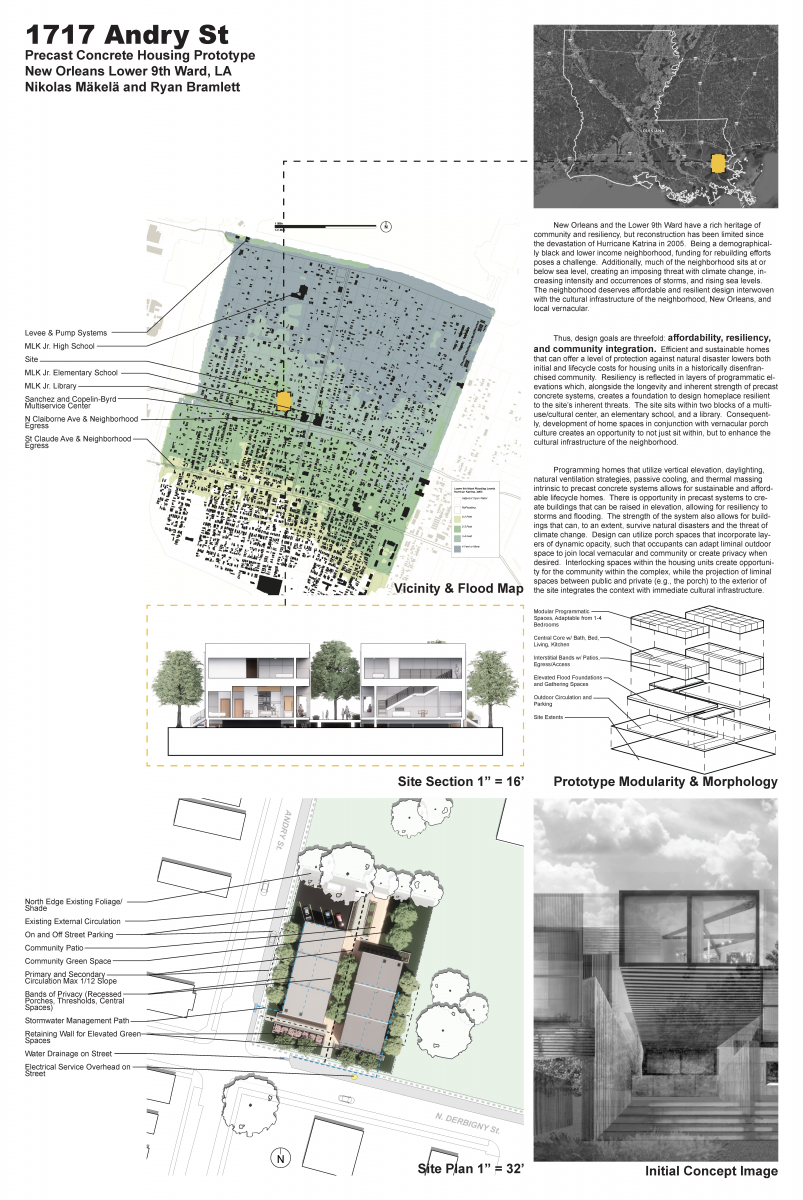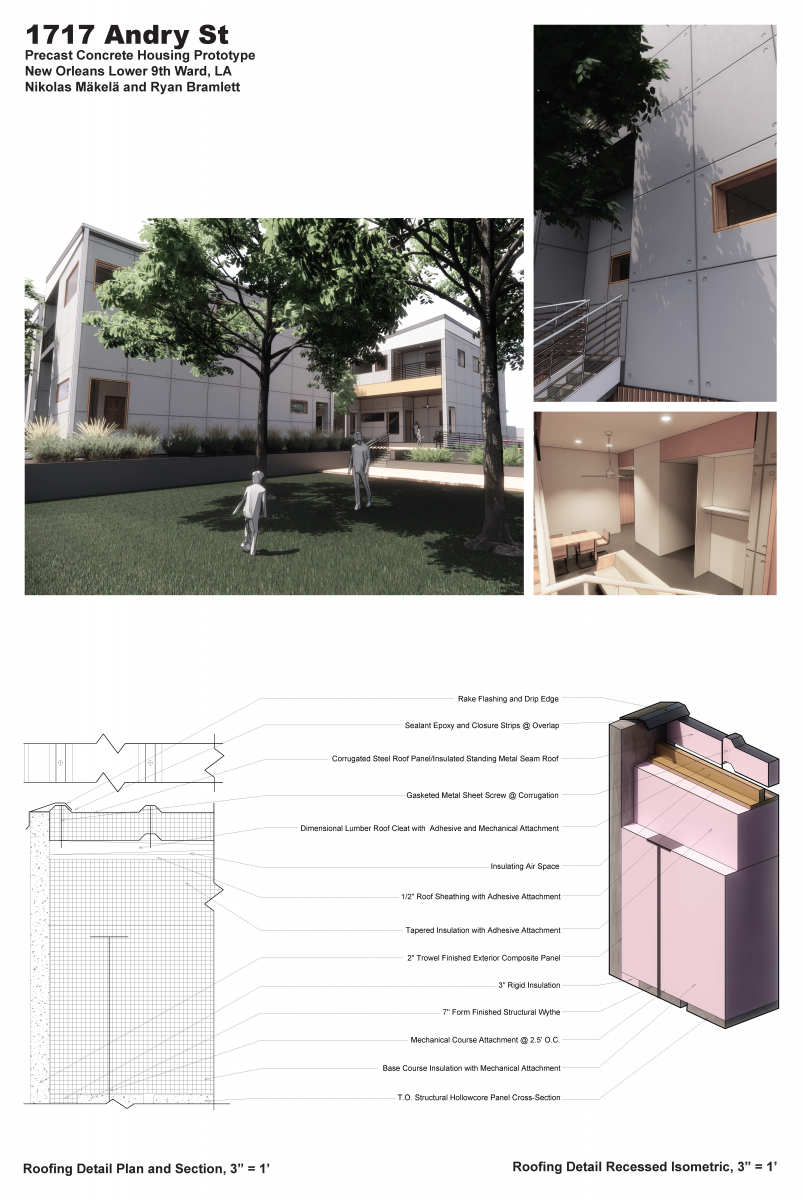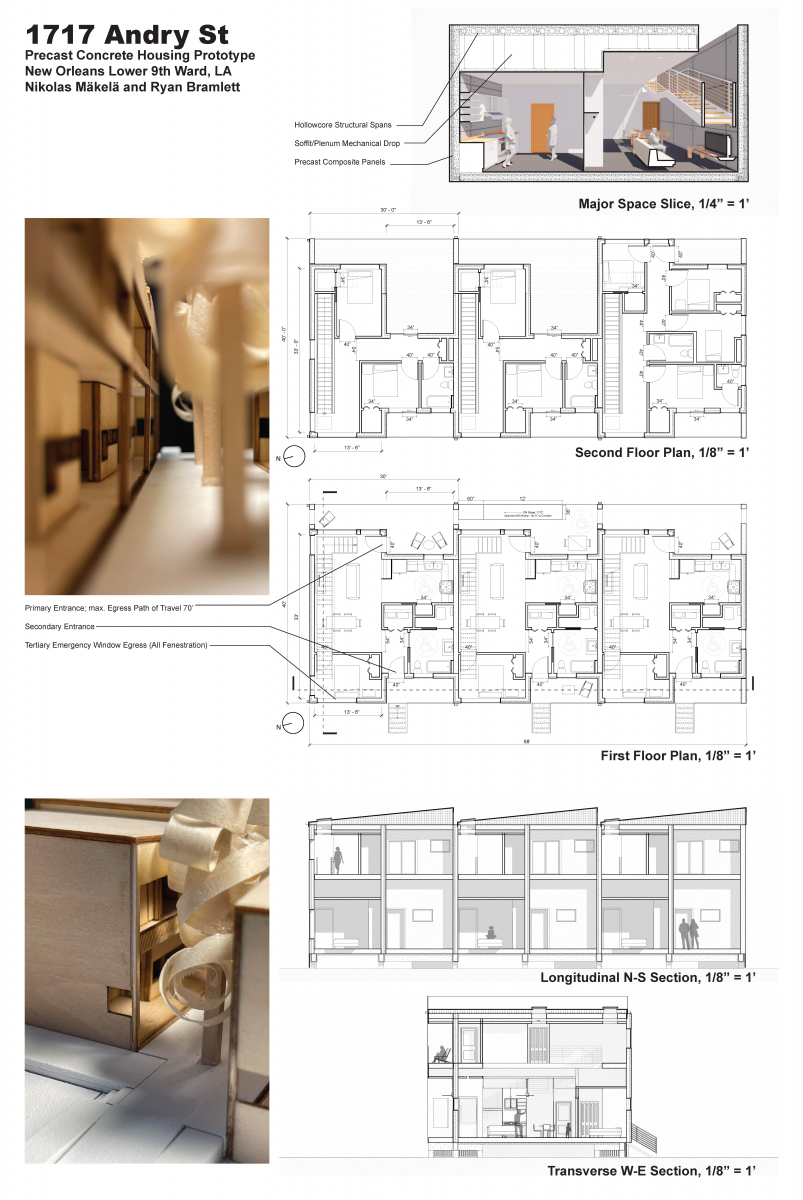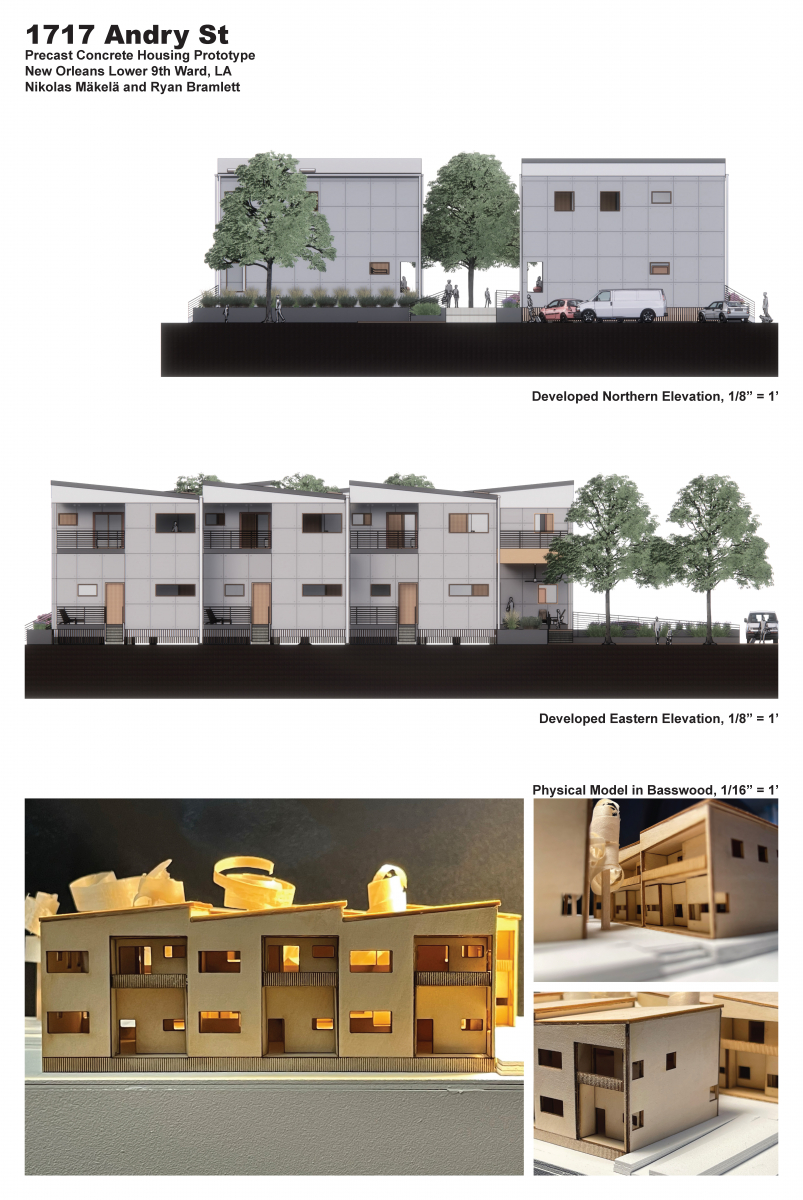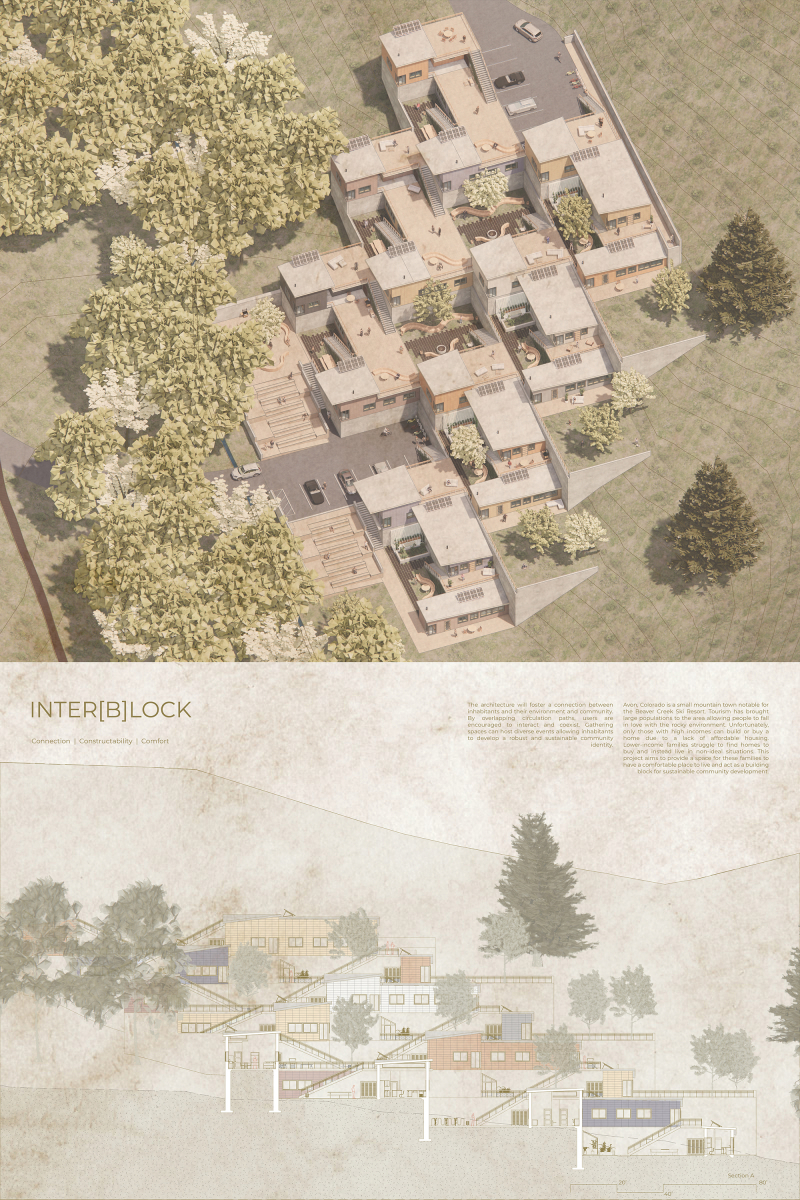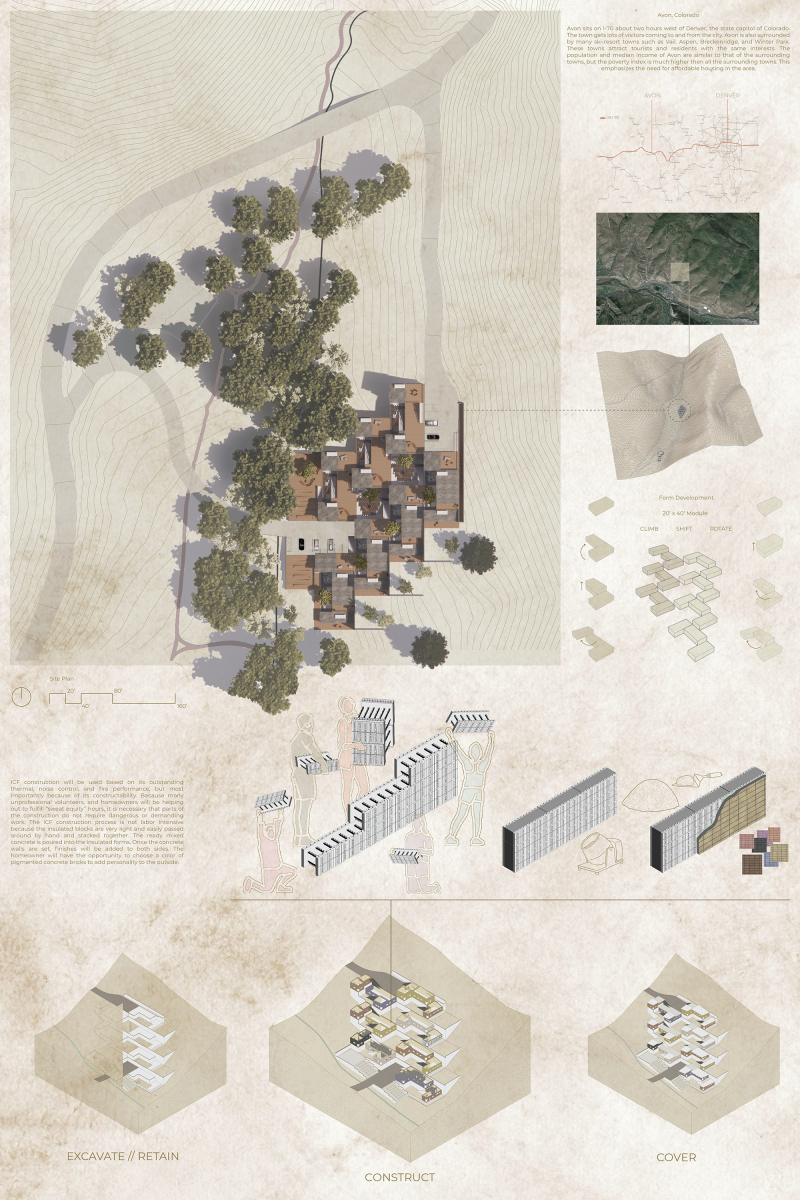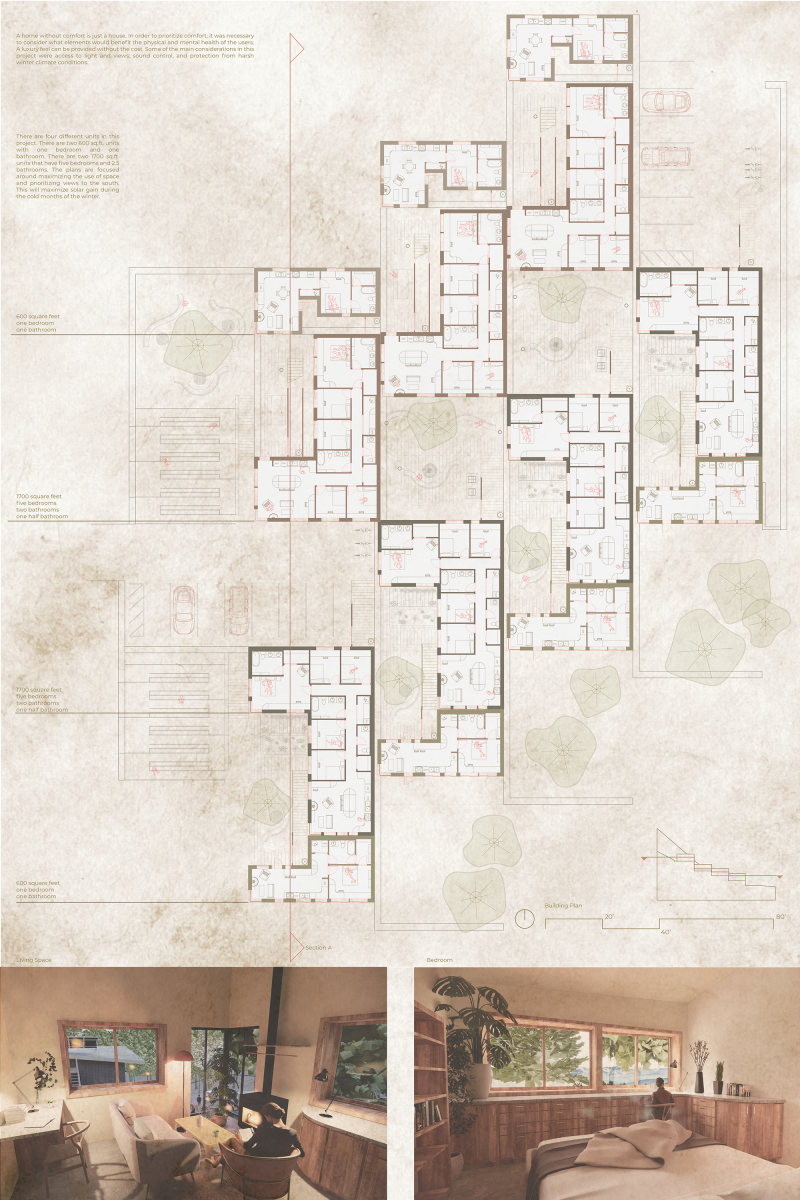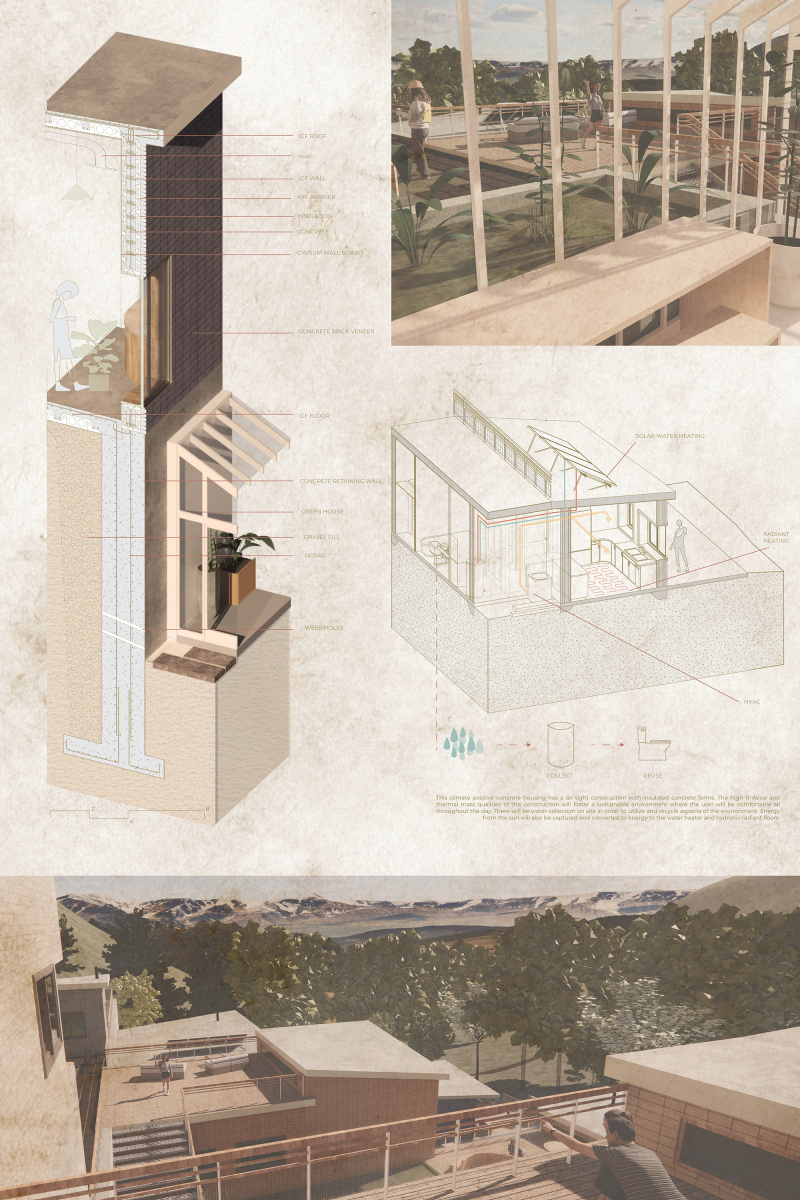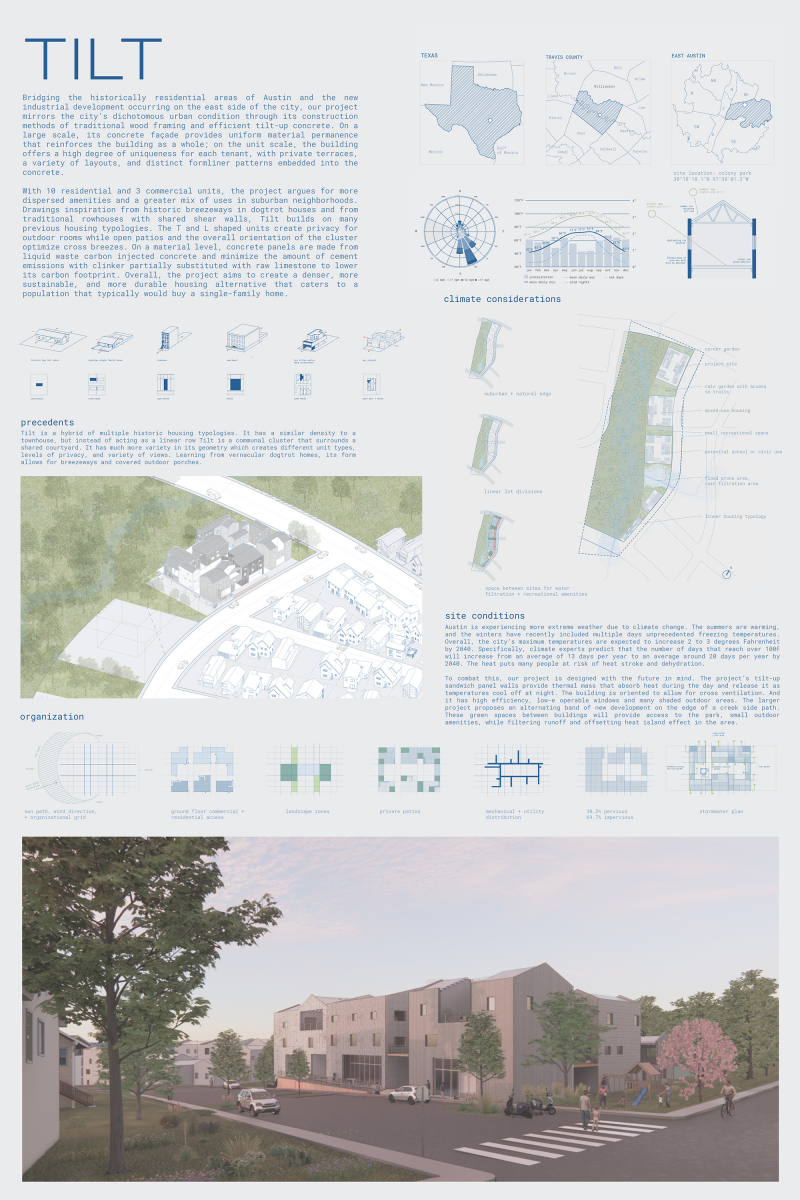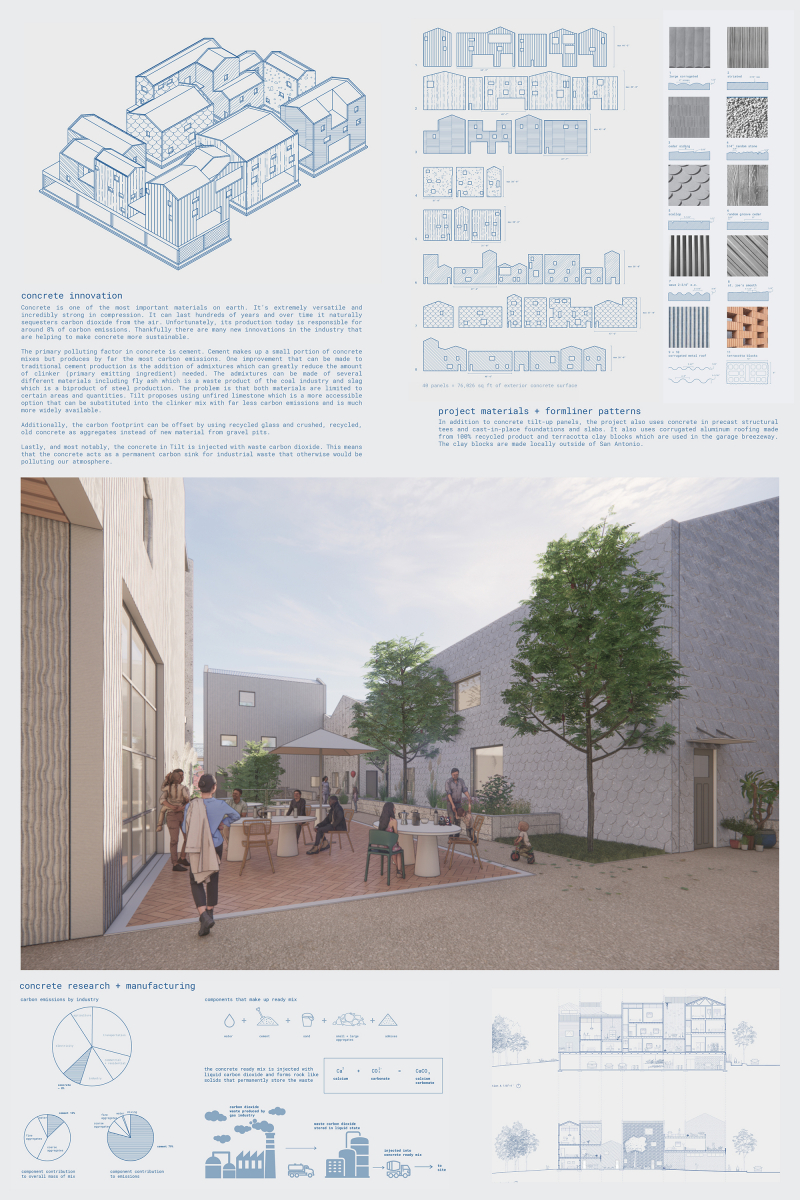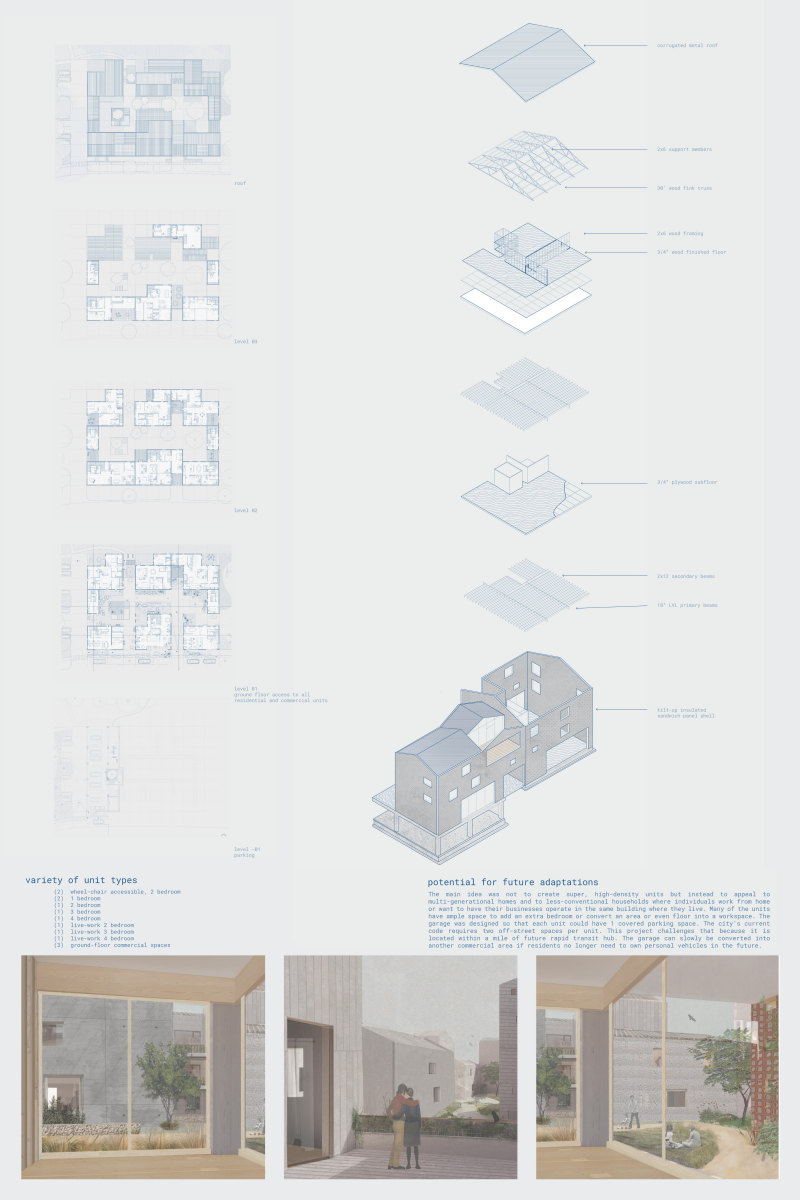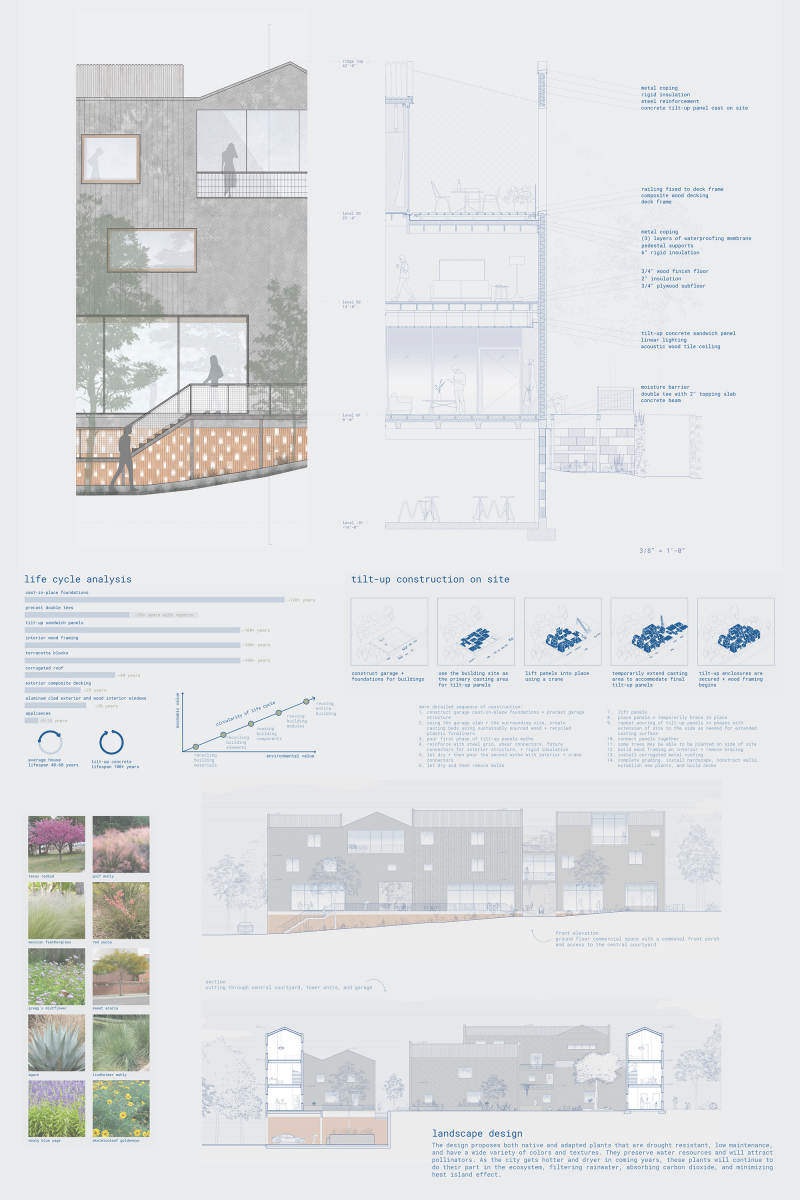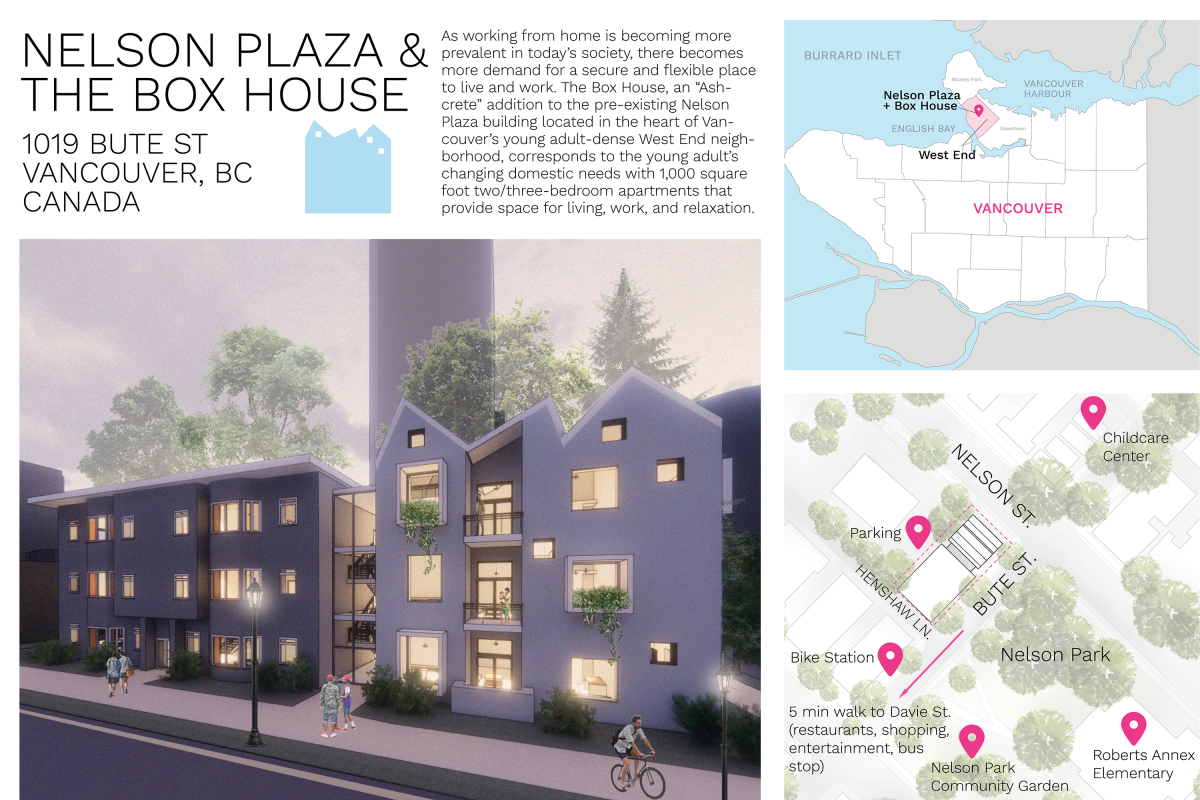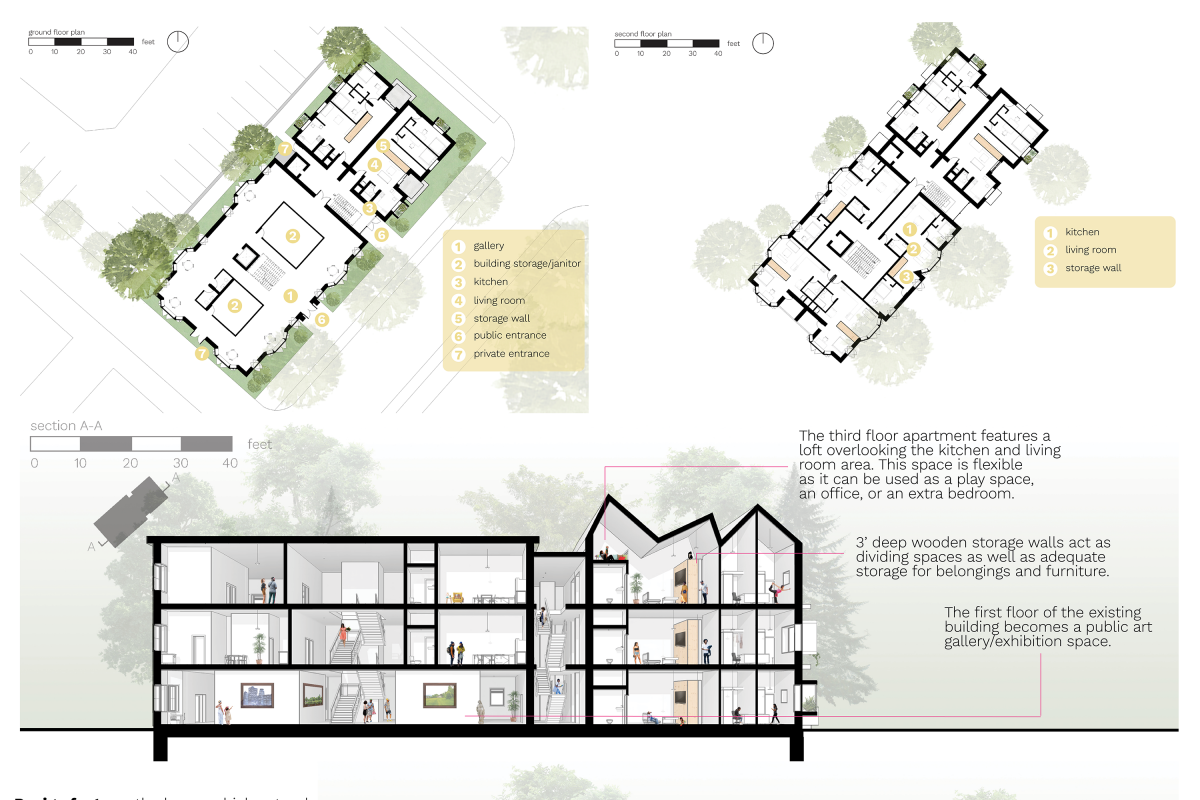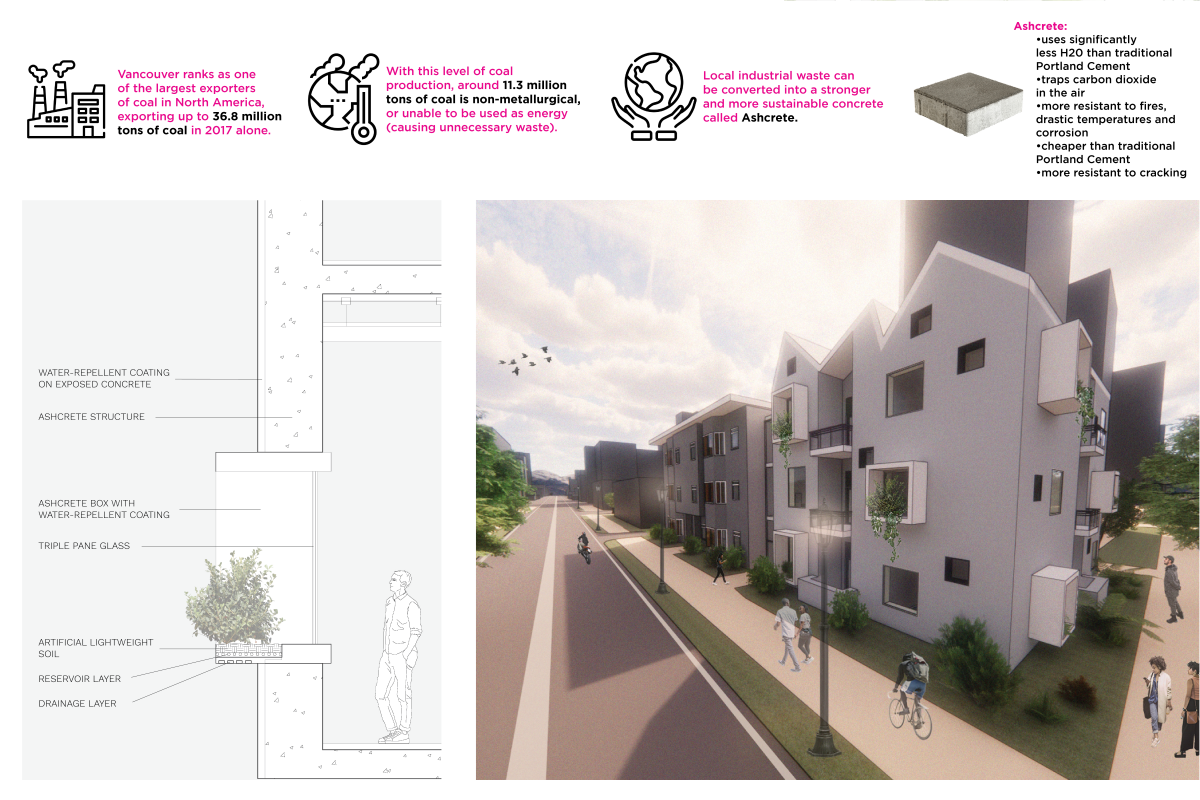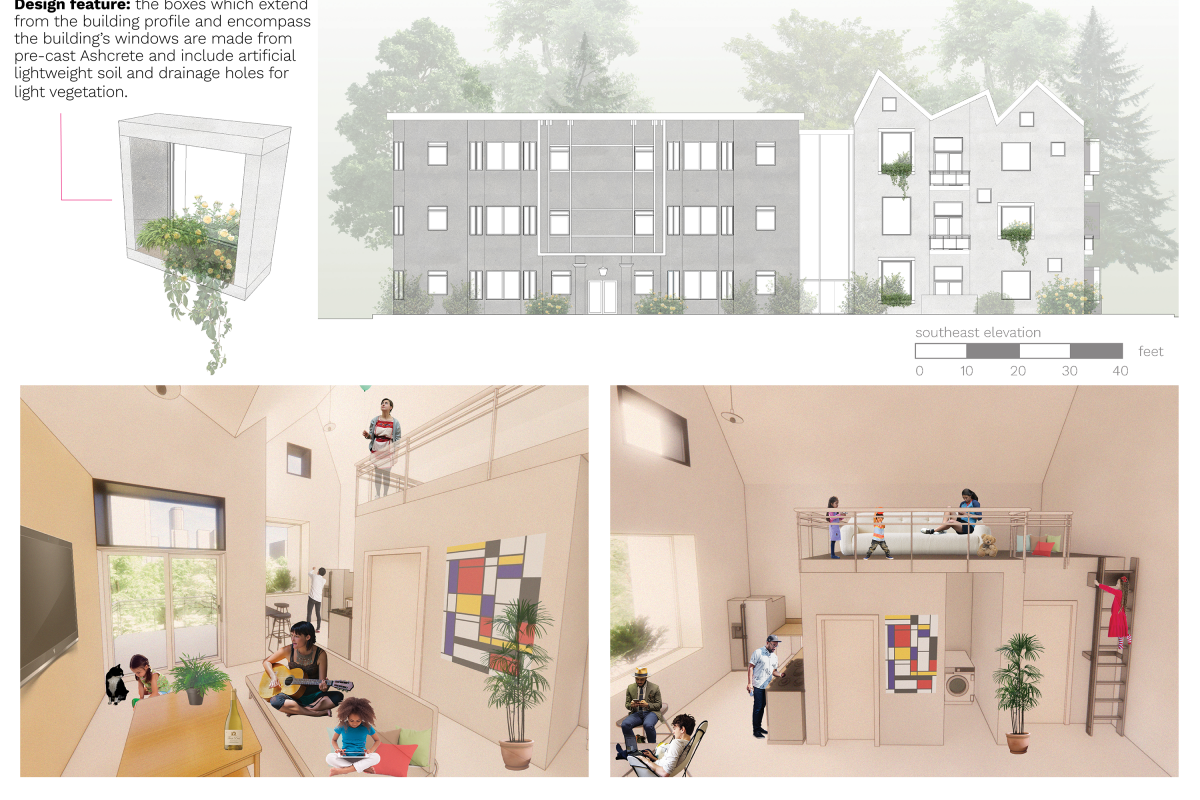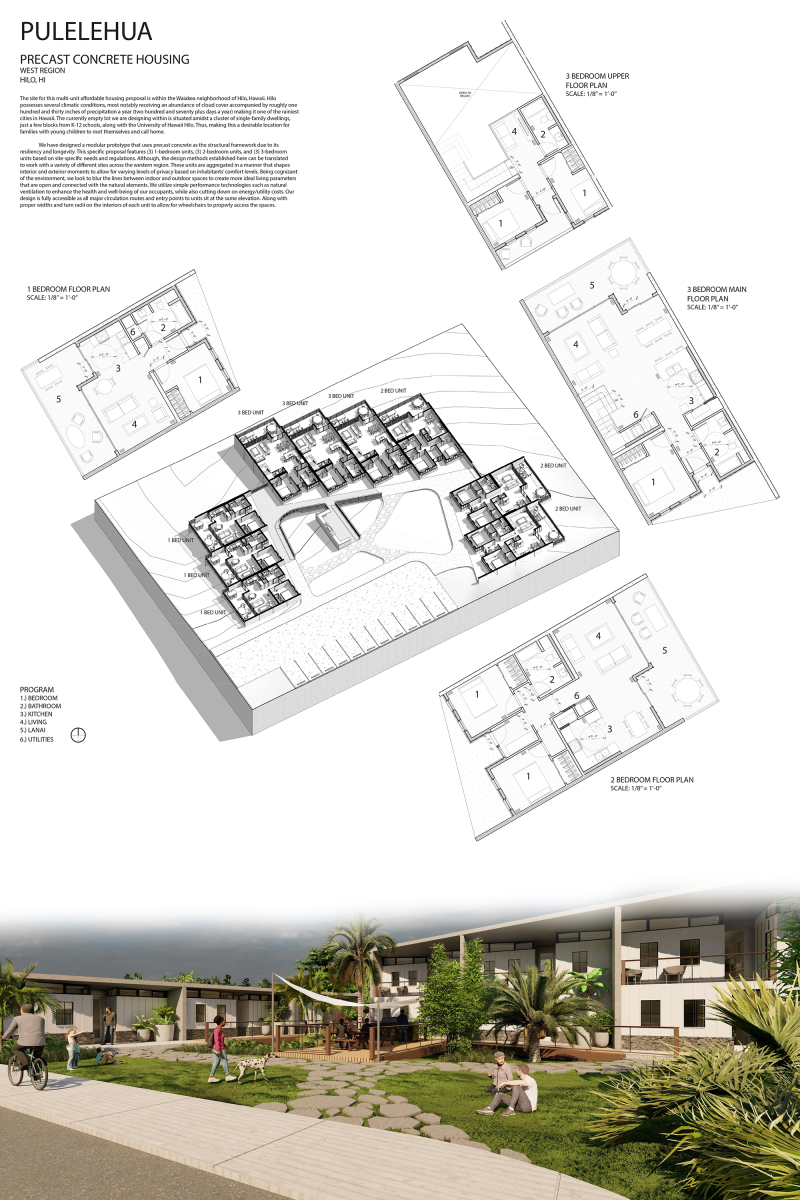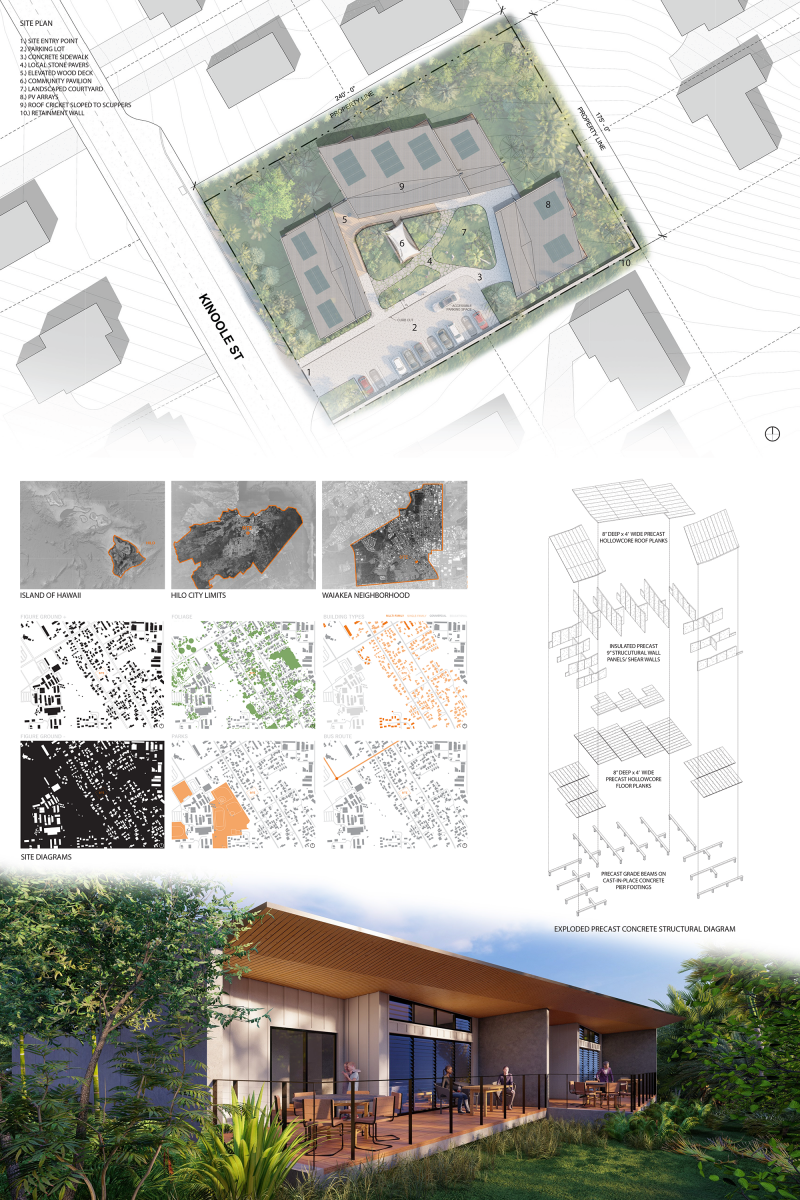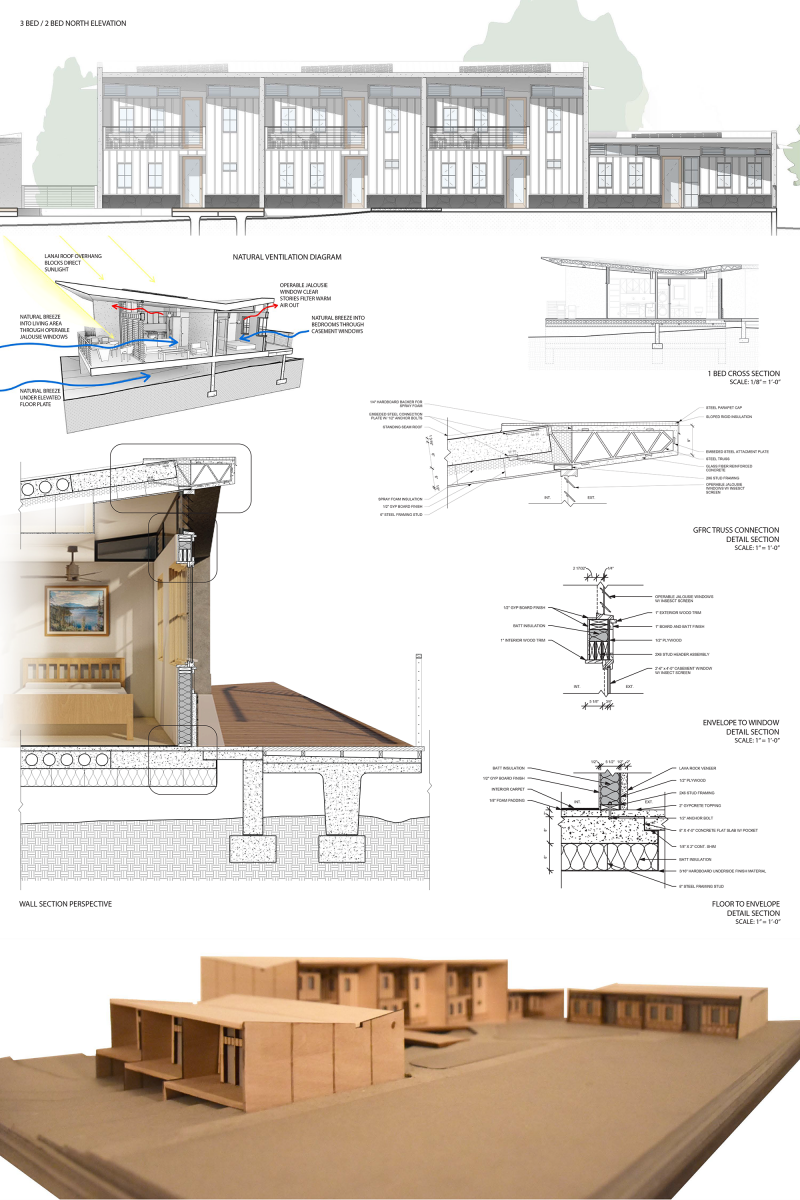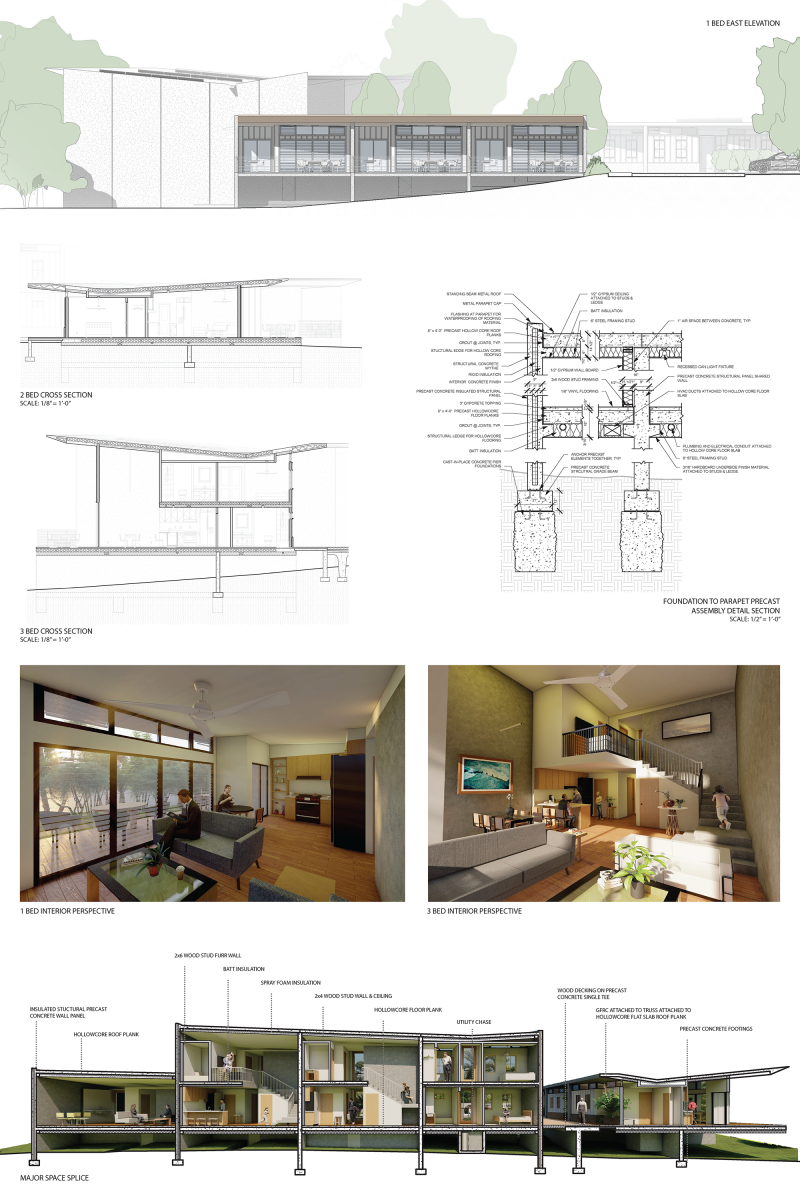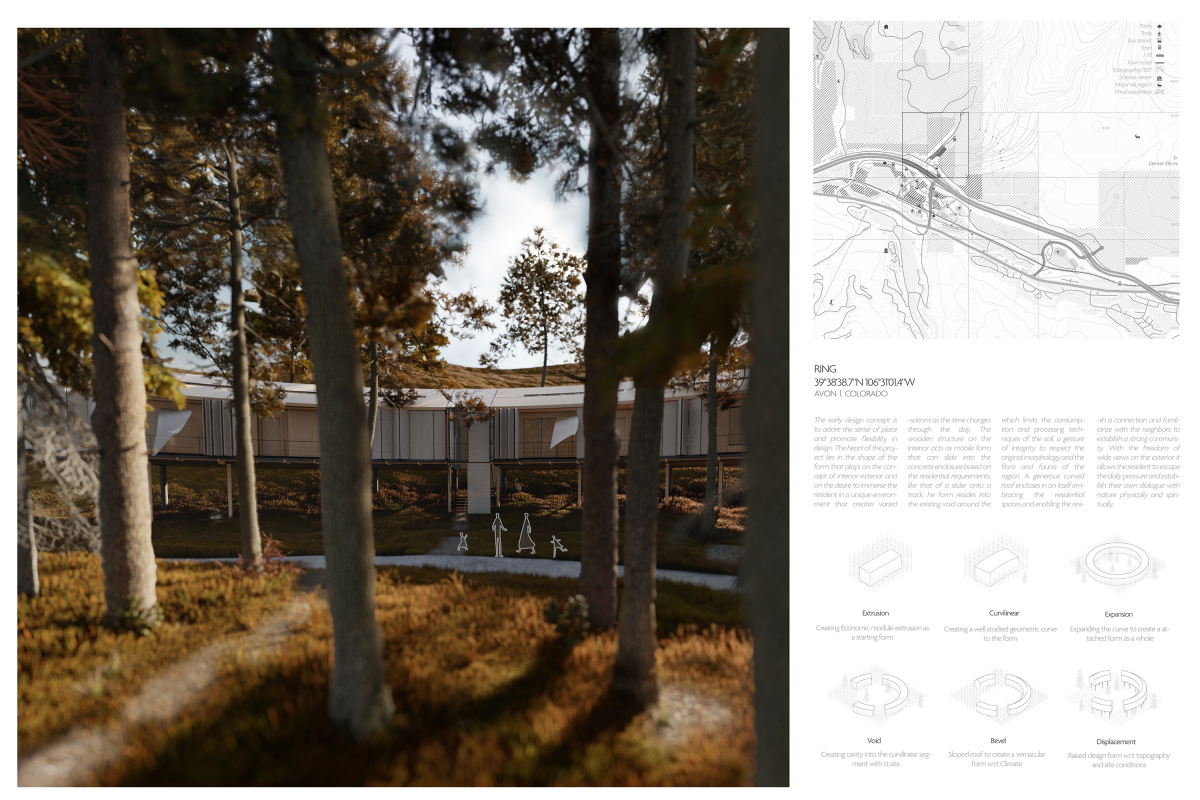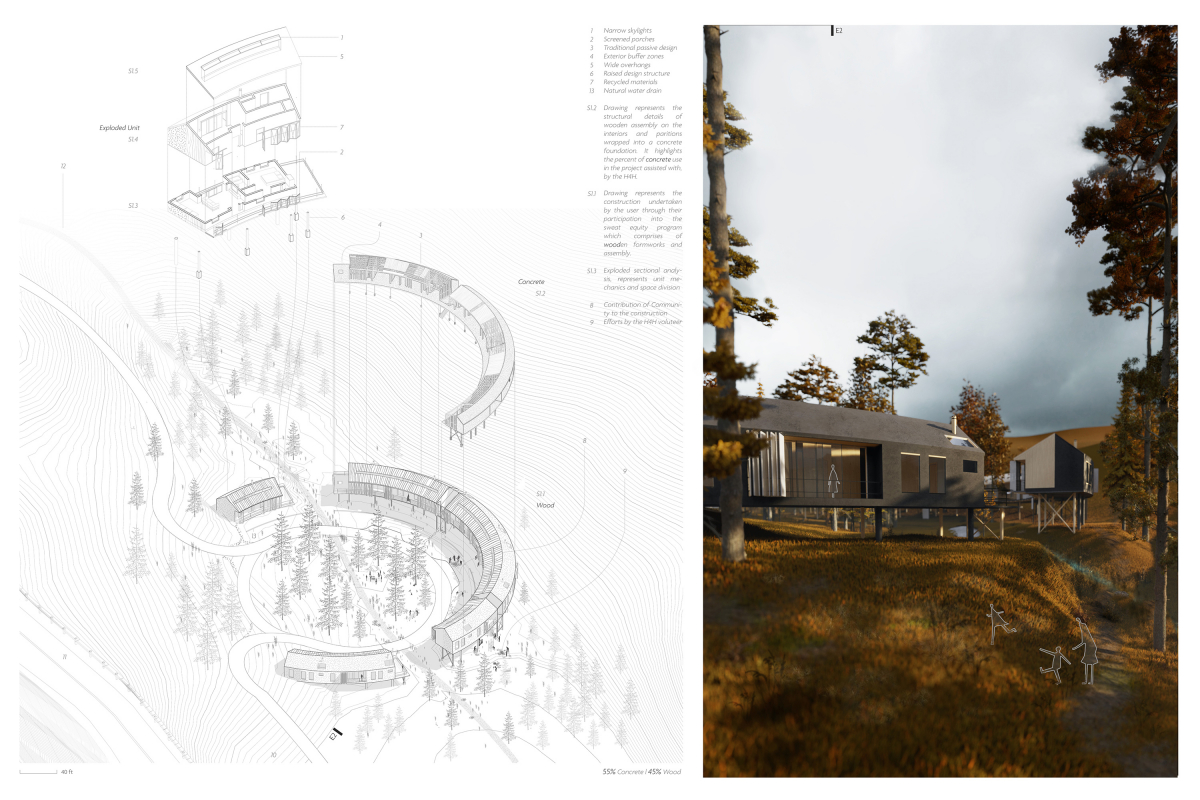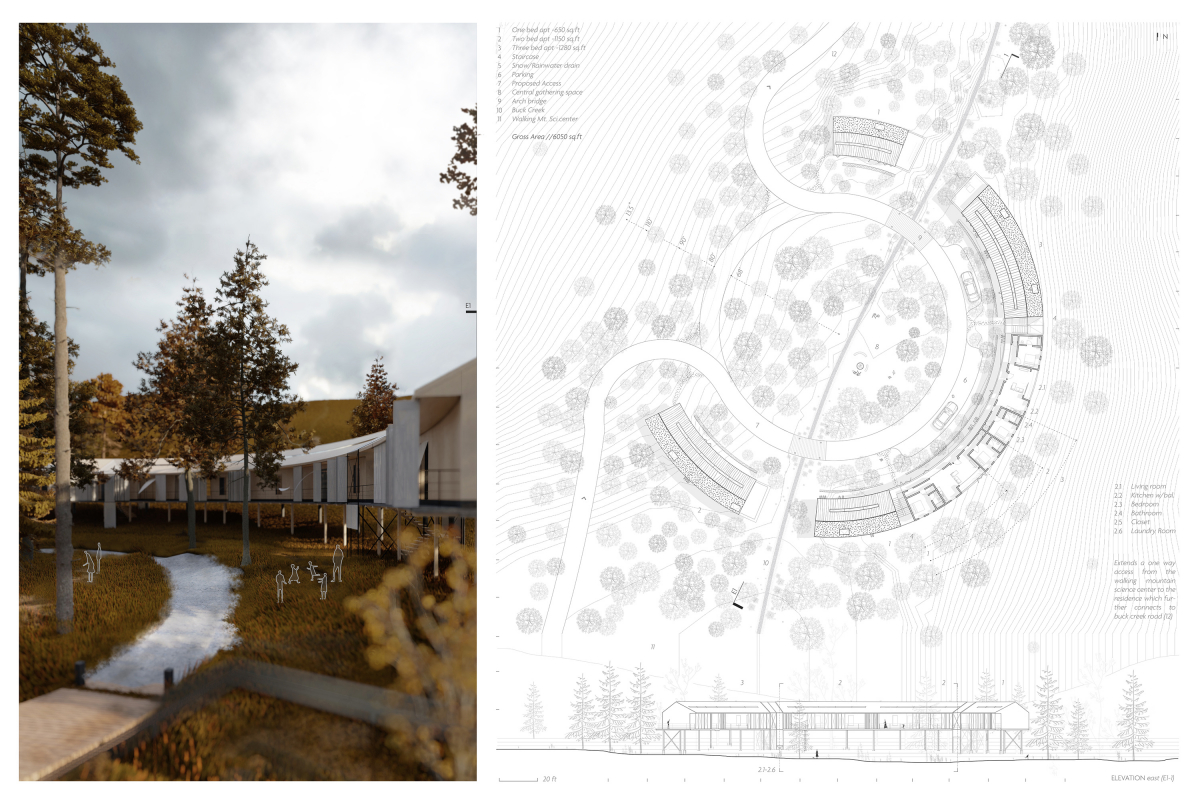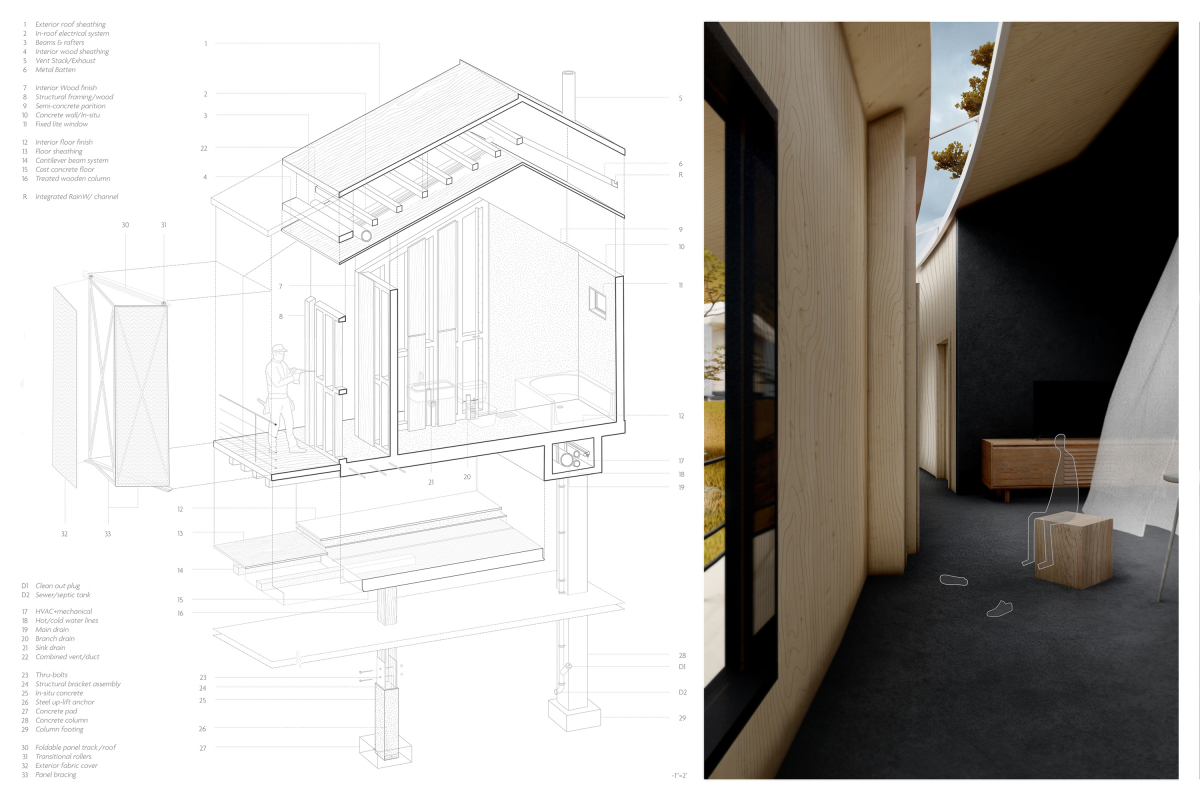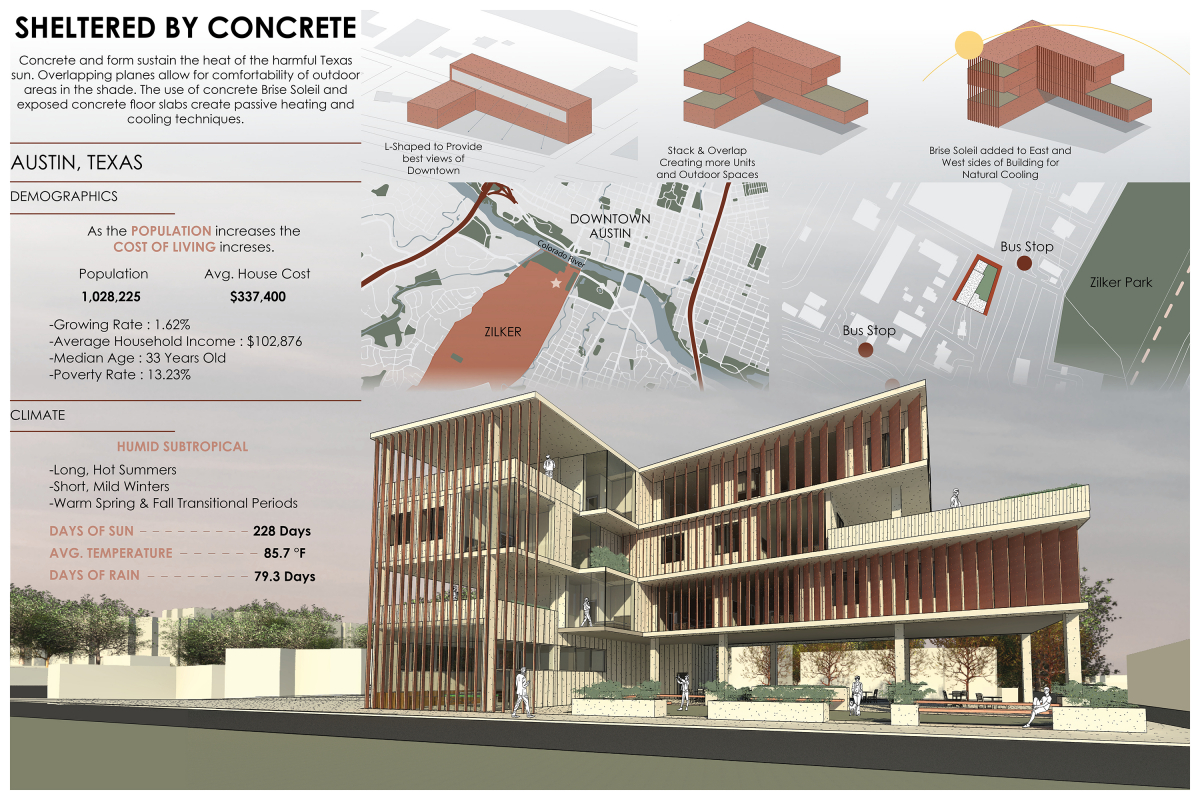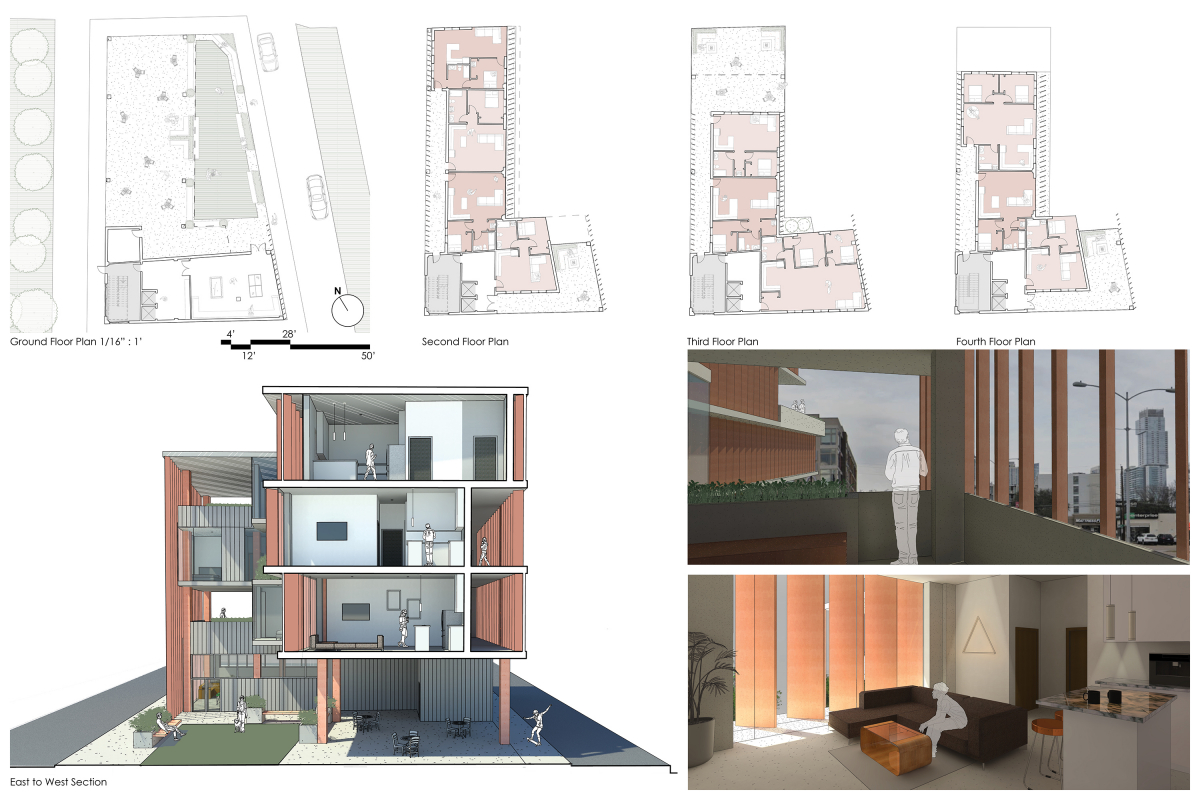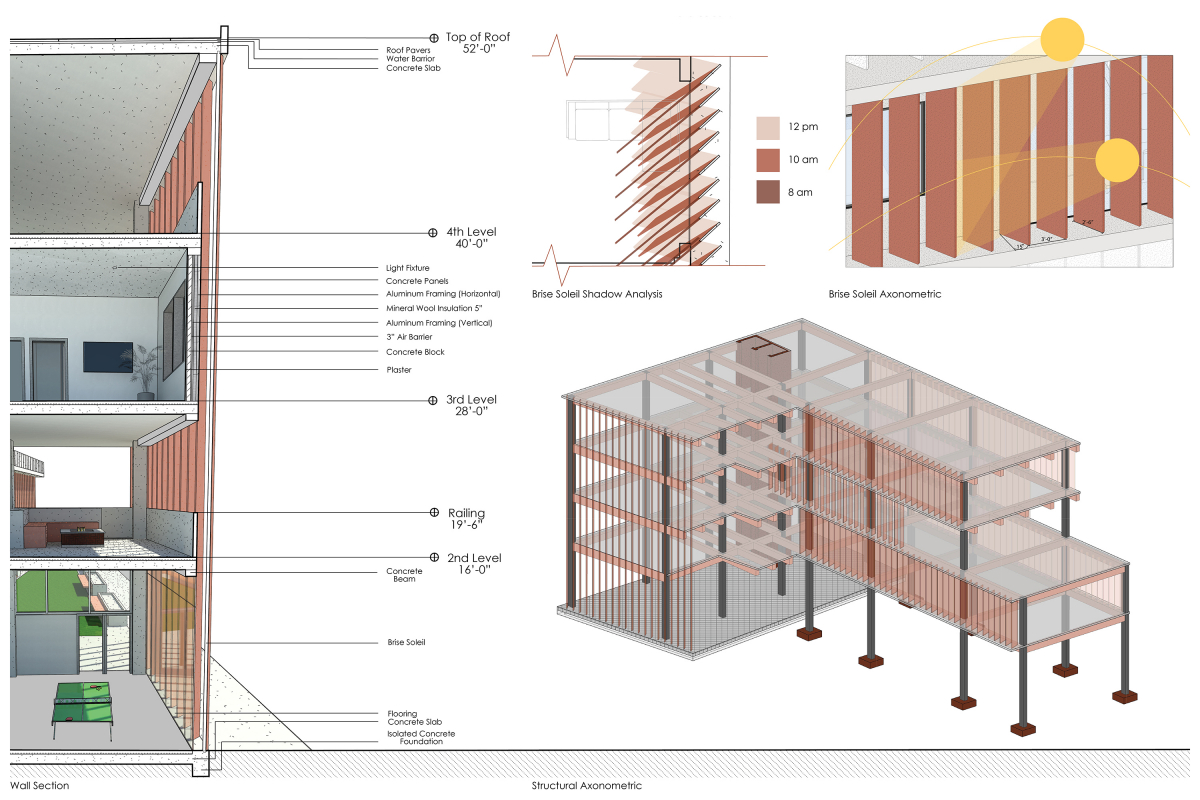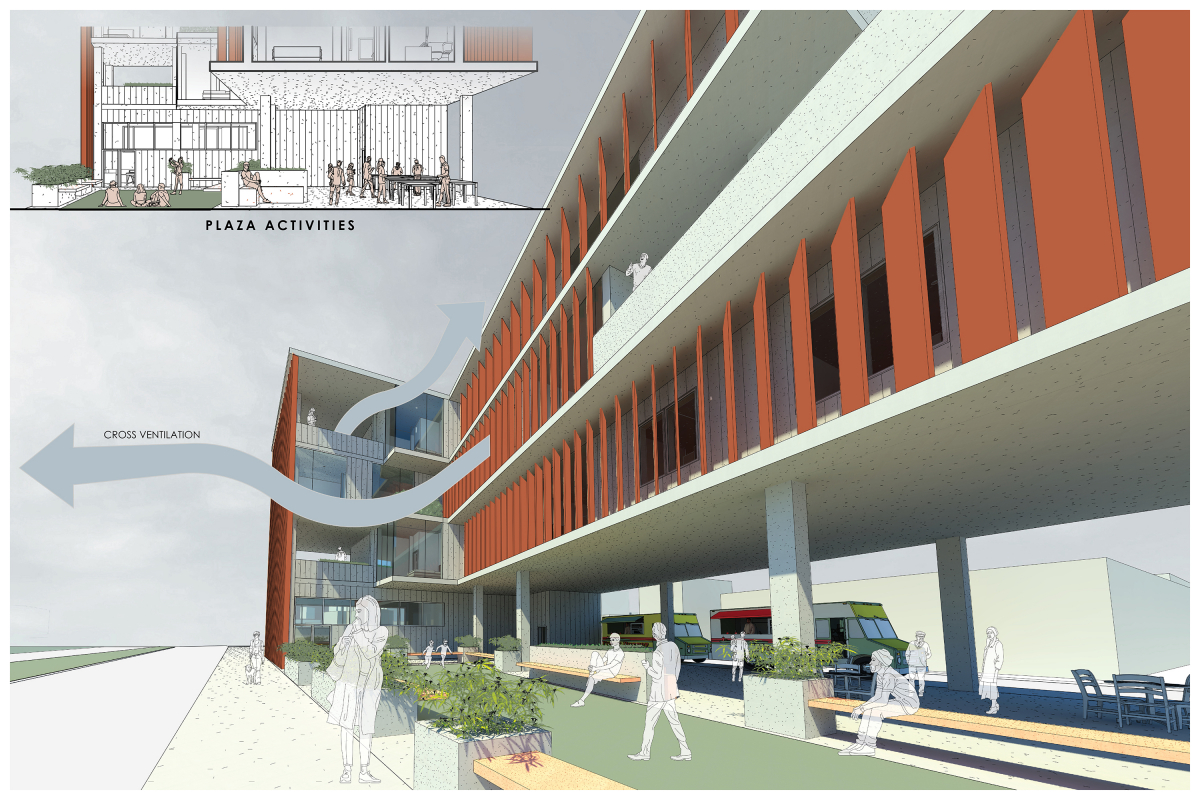Winners of the 2022 Habitat Competition
The National Ready Mixed Concrete Association (NRMCA) and Habitat for Humanity International, Inc., in partnership with the Association of Collegiate Schools of Architecture (ACSA), are pleased to announce the winners of the 2022 Habitat Design Competition: Climate Positive Concrete Housing. The competition recognizes seven exceptional projects that demonstrate affordable multi-unit housing in North America. The program challenged students to envision a creative and clear approach to designing a Habitat Home.
Jury
The jury for the 2022 Habitat Competition includes:

Molly Berg
Habitat for Humanity International

Chris Drew
Adrian Smith + Gordon Gill Architecture
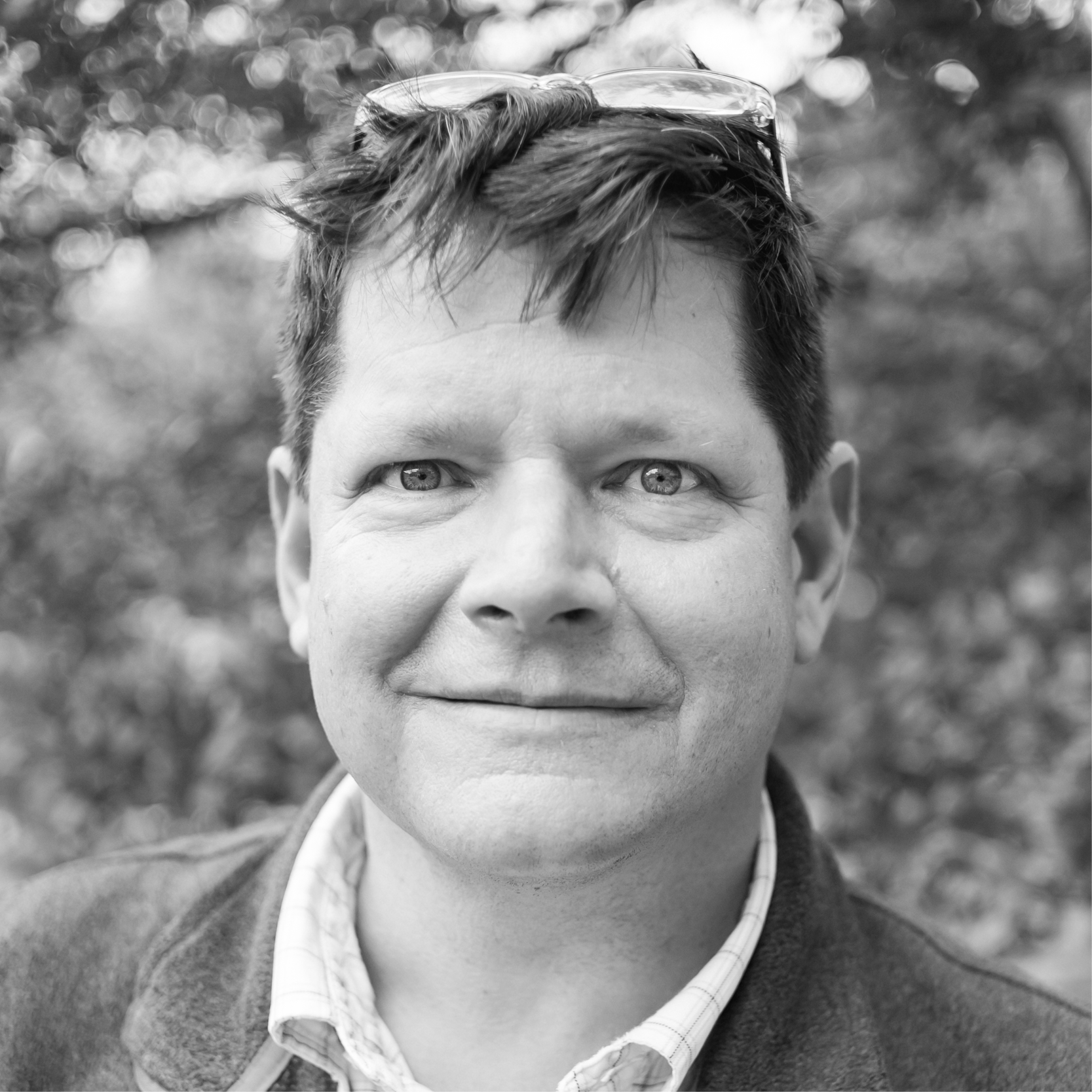
Paul Holley
Auburn University

Tsz Yan Ng
University of Michigan
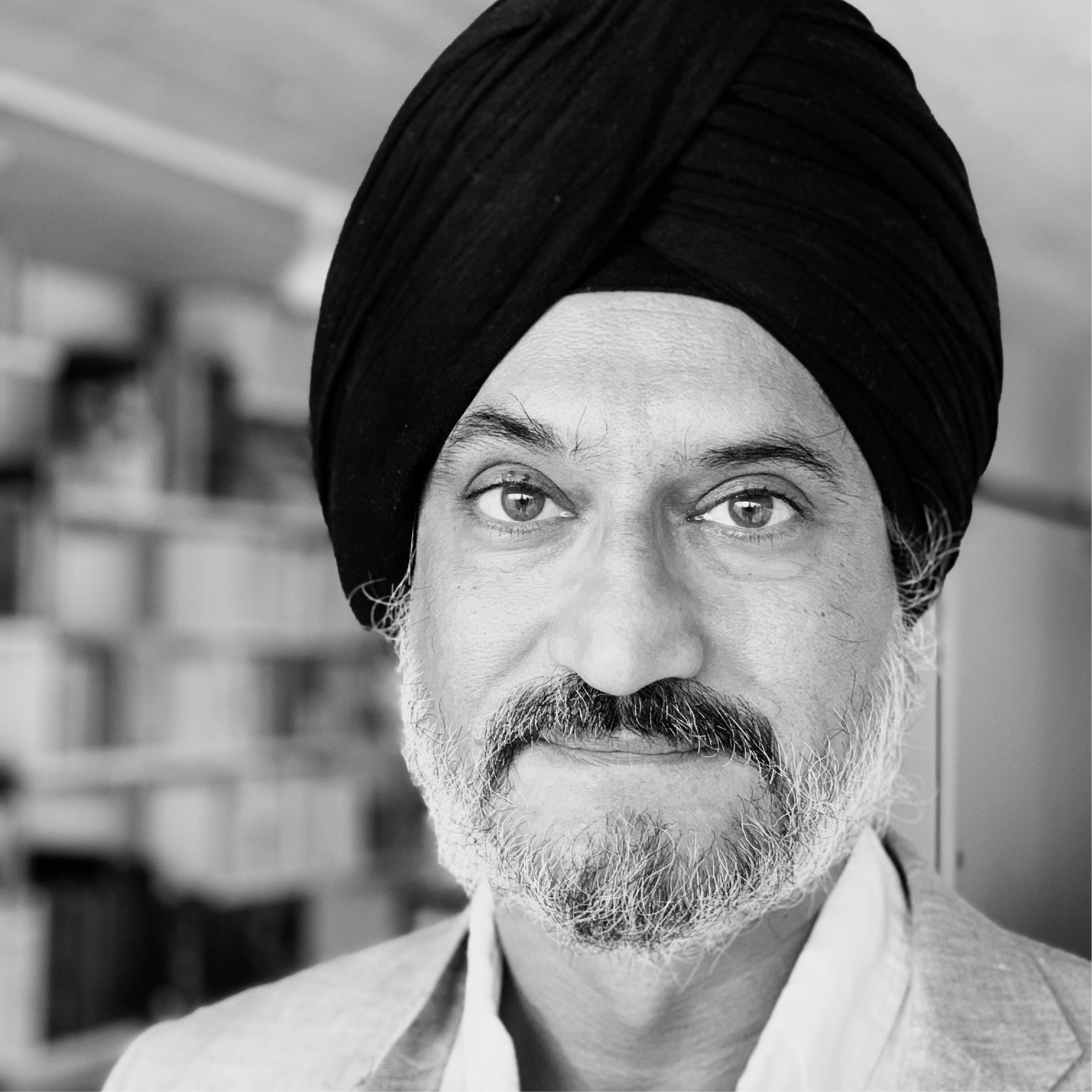
Jasmit Rangr
University of California, Berkeley
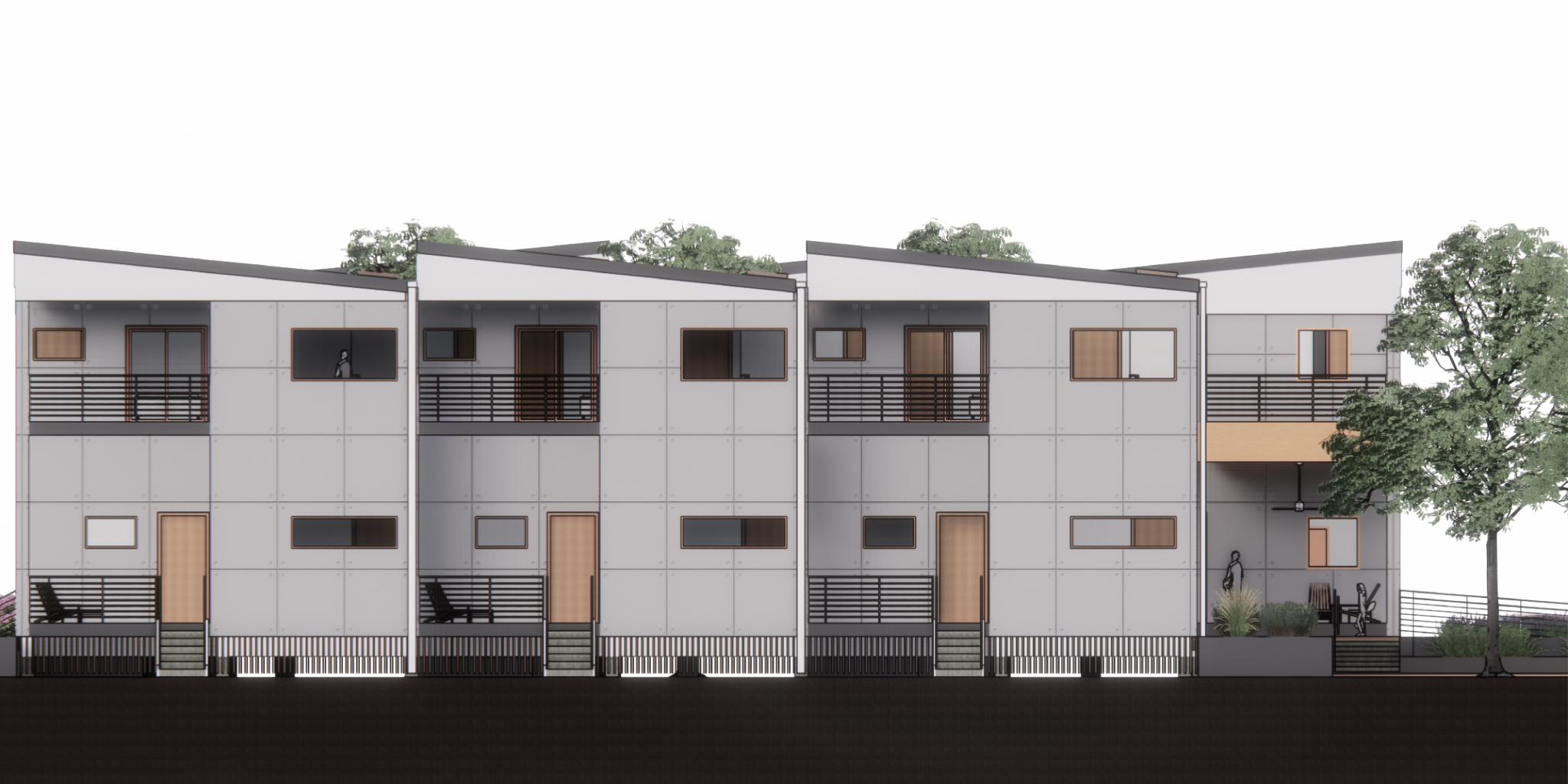

South Region Winner
1717 Andry St., Precast Prototype
Students: Ryan Bramlett & Nikolas Makela
Faculty Sponsor: Matthew Shea
Institution: University of Colorado Denver
1717 Andry St., Precast Prototype is the winner for the South region, showcasing an integrated community design using precast concrete construction systems. The project includes vernacular design of porches, with public program strategies integrated. The depth of the façade is effectively presented by pushing back the balconies, thus activating the zone between the private and the public. Programmatically the project introduces solutions in having higher density plans built for Habitat homes.
Project Description
New Orleans and the Lower 9th Ward have a rich heritage of community and resiliency, but reconstruction has been limited since the devastation of Hurricane Katrina in 2005. Being a demographically black and lower income neighborhood, funding for rebuilding efforts poses a challenge. Additionally, much of the neighborhood sits at or below sea level, creating an imposing threat with climate change, increasing intensity and occurrences of storms, and rising sea levels. The neighborhood deserves affordable and resilient design interwoven with the cultural infrastructure of the neighborhood, New Orleans, and local vernacular.
Thus, design goals are threefold: affordability, resiliency, and community integration. Efficient and sustainable homes that can offer a level of protection against natural disaster lowers both initial and lifecycle costs for housing units in a historically disenfranchised community. Resiliency is reflected in layers of programmatic elevations which, alongside the longevity and inherent strength of precast concrete systems, creates a foundation to design home place resilient to the site’s inherent threats. The site sits within two blocks of a multi-use/cultural center, an elementary school, and a library. Consequently, development of home spaces in conjunction with vernacular porch culture creates an opportunity to not just sit within, but to enhance the cultural infrastructure of the neighborhood.
Programming homes that utilize vertical elevation, daylighting, natural ventilation strategies, passive cooling, and thermal massing intrinsic to precast concrete systems allows for sustainable and affordable lifecycle homes. There is opportunity in precast systems to create buildings that can be raised in elevation, allowing for resiliency to storms and flooding. The strength of the system also allows for buildings that can, to an extent, survive natural disasters and the threat of climate change. Design can utilize porch spaces that incorporate layers of dynamic opacity, such that occupants can adapt liminal outdoor space to join local vernacular and community or create privacy when desired. Interlocking spaces within the housing units create opportunity for the community within the complex, while the projection of liminal spaces between public and private (e.g., the porch) to the exterior of the site integrates the context with immediate cultural infrastructure.
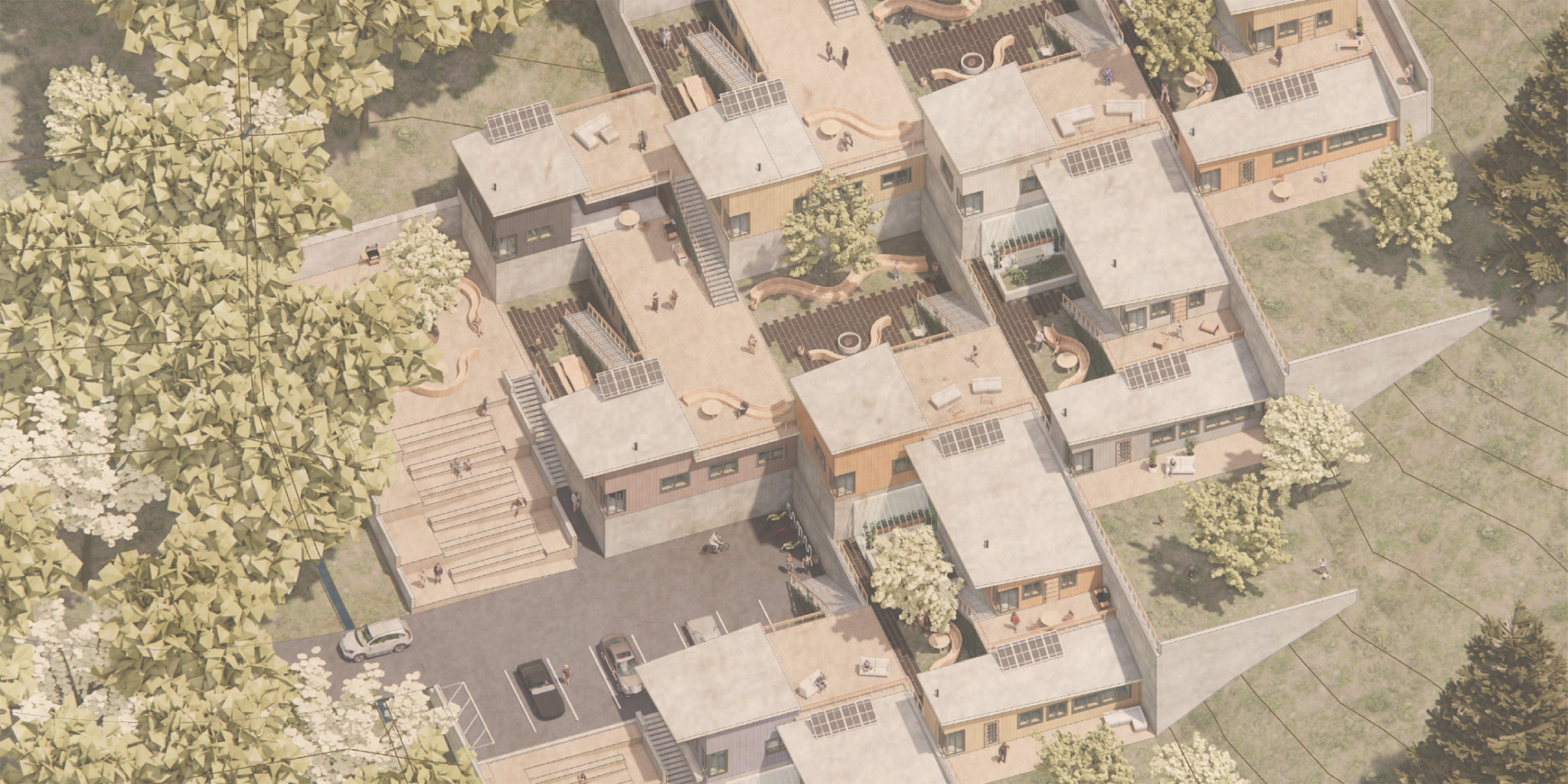
West Region Winner
Inter[B]lock
Student: Abby Loftus
Faculty Sponsor: Margaret McManus
Institution: Savannah College of Art and Design
Project Description
Avon, Colorado is a small mountain town notable for the Beaver Creek Ski Resort. Tourism has brought large populations to the area allowing people to fall in love with the rocky environment. Unfortunately, only those with high incomes can build or buy a home due to a lack of affordable housing. Lower-income families struggle to find homes to buy and instead live in non-ideal situations. This project aims to provide a space for these families to have a comfortable place to live and act as a building block for sustainable community development.
The architecture will foster a connection between inhabitants and their environment and community. By overlapping circulation paths, users are encouraged to interact and coexist. Gathering spaces can host diverse events allowing inhabitants to develop a robust and sustainable community identity.
This project will partner with Habitat for Humanity and with Build With Strength who will donate concrete for construction. Ready-mixed concrete will be poured into prefab insulating forms. This construction method is known as Insulated Concrete Forms. ICF construction will be used based on its outstanding thermal properties, noise control, and fire risk mitigation, but most importantly because of its constructability. Because many volunteers and homeowners will be helping to fulfill ìsweat equityî hours, it is necessary for construction to not require too dangerous or demanding work. The ICF process is not labor-intensive as insulated blocks are lightweight and easily transported and can be handled in assembly lines on-site.
A home without comfort is just a house. To prioritize comfort, it was necessary to consider what elements would benefit the health of the users. Luxury can be provided without cost. Some of the main considerations in this project were access to light and views, sound control, and protection from harsh winter climate conditions.
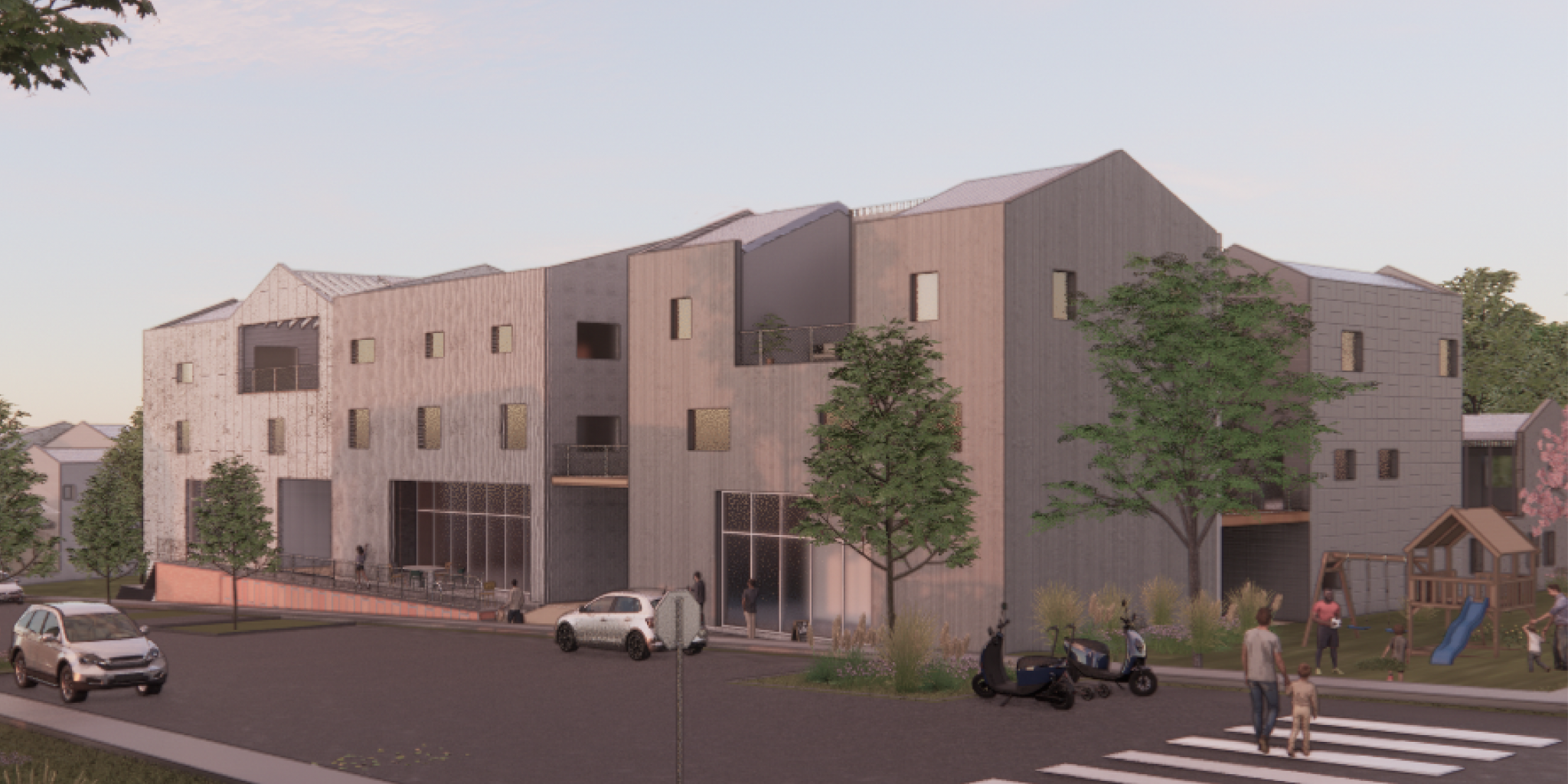
Central Region Winner
Tilt
Students: Stella Coble & Michelle Powell
Faculty Sponsor: Martin Hättasch
Institution: University of Texas at Austin
Project Description
Bridging the historically residential areas of Austin and the new industrial development on the east side of the city, Tilt mirrors the city’s dichotomous urban condition through its construction methods of traditional wood framing and efficient tilt-up concrete. On a large scale, its concrete façade provides uniform material permanence that reinforces the building as a whole; on the unit scale, the building offers a high degree of uniqueness for each tenant, with private terraces, a variety of layouts, and distinct formliner patterns embedded into the concrete.
Tilt bridges many previous housing precedents, creating a hybrid typology. It draws inspiration from historic breezeways in dogtrot houses and shared shear wall construction in row houses while maintaining traditional townhouse density. But rather than acting as a linear row, Tilt has much more variety in its geometry, allowing for different unit types, levels of privacy, and variety of views. The T and L shaped units create privacy for outdoor rooms while open patios and the overall orientation of the cluster optimize cross breezes. Learning from vernacular dogtrot homes, its form allows for breezeways and covered outdoor porches. With 10 residential and 3 commercial units that encapsulate a shared courtyard, the project argues for more dispersed amenities and a greater mix of uses in suburban neighborhoods.
The main idea was not to create super high-density units, but rather to appeal to multi-generational homes and to less-conventional households where individuals work from home or want to have their businesses operate in the same building where they live. Many of the units have ample space to add an extra bedroom or convert an area or even an entire floor into a workspace. Additionally, because of the project’s close proximity to a future light rail station, the covered parking was designed with the hope that it can be converted into another commercial or studio space when personal vehicle parking is not needed.
The landscape design also reflects the goal of longevity. The design proposes both native and adapted plants that are drought resistant, low maintenance, and have a wide variety of colors and textures. They preserve water resources and will attract pollinators. As the city gets hotter and dryer in coming years, these plants will continue to do their part in the ecosystem, filtering rainwater, absorbing carbon dioxide, and minimizing heat island effect.
On a material level, concrete panels are made from liquid waste carbon injected concrete and minimize the amount of cement emissions with clinker partially substituted with raw limestone to lower its carbon footprint. In addition to concrete tilt-up panels, the project also uses concrete in precast structural tees and cast-in-place foundations and slabs. It also uses corrugated roofing made from 100% recycled product and terracotta clay blocks, sourced from San Antonio, which are used in the garage breezeway. Overall, the project aims to create a denser, more sustainable, and more durable housing alternative that caters to a population that typically would buy a single-family home, and will remain flexible throughout shifting demographic and climatic realities.
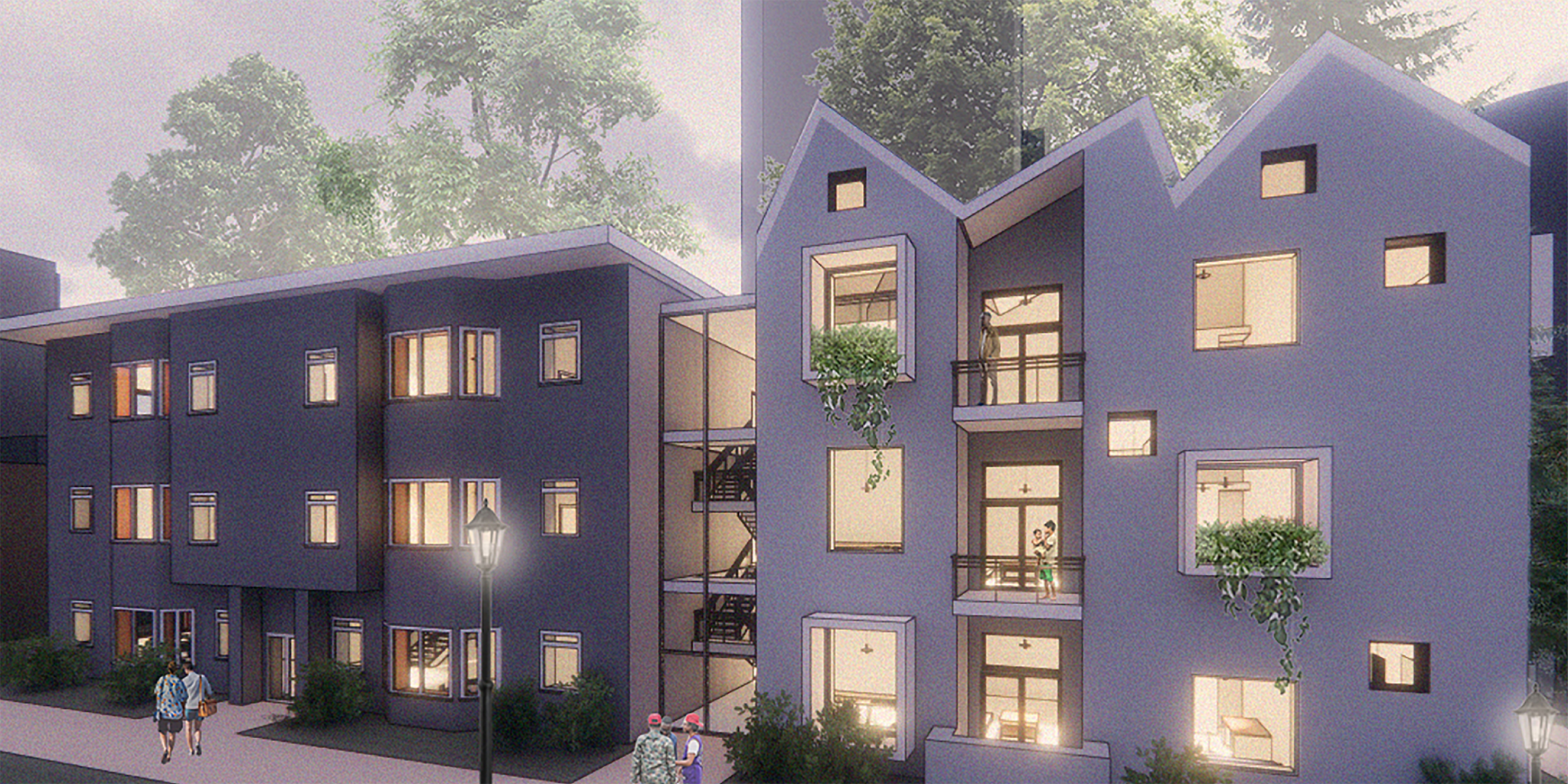
North Region Winner
Nelson Plaza + Box House Extension
Student: Bella Scott
Faculty Sponsor: Randall Deutsch
Institution: University of Illinois, Urbana-Champaign
Nelson Plaza + Box House Extension is a top winner with a thorough understanding of how to site and respond to the North region. The use of fly ash based concrete as the main construction material shows a good understanding of low-carbon cement alternatives. The student brought a holistic approach from concrete material consideration through an impressive environmental response. The design also emphasized inhabitation through higher density living and flexible live/work space that is quite compelling.
Project Description
The Nelson Plaza with Box House extension features two distinctive apartment buildings, one already existing and the other as a connecting infill project. The decision to add the Box House extension to the pre-existing Nelson Plaza apartment building reflects the changing post-modern domestic needs of the rapidly-growing young adult population located in the urban West End neighborhood of Vancouver. The addition offers 1,000 square foot spaces for two and three-bedroom occupants to reside, with space and furniture that can be moved to accommodate working from home/remotely, social gatherings, and visitors.
Vancouver is one of the largest exporters of coal in North America, with exports in the latter half of this decade totaling up to 39 million tons per year. From this level of coal production, about a third of it is non-metallurgical, or unable to be used properly for energy, generating excess waste in the region. Hence, the main construction material for the infill Box House is “Ashcrete”, a concrete substitute consisting of recycled fly ash and other industrial waste. The substance is generally stronger and is able to last longer than traditional concrete, allowing the building to exist longer in the moderate Vancouver climate.
Additional design features include concrete boxes or “pleats” extend from the building’s facade and contain plants that are watered by Vancouver’s ample amount of precipitation per year. This precipitation is also caught by the M-shaped roof of the Box House and is filtered through a cistern system, which then sends recycled water back to the building as a primary water source, eliminating the need for reliance on watershed sourcing from the local North Shore and Coquitlam mountains. These two small yet important details help support the local environment of the West End neighborhood.
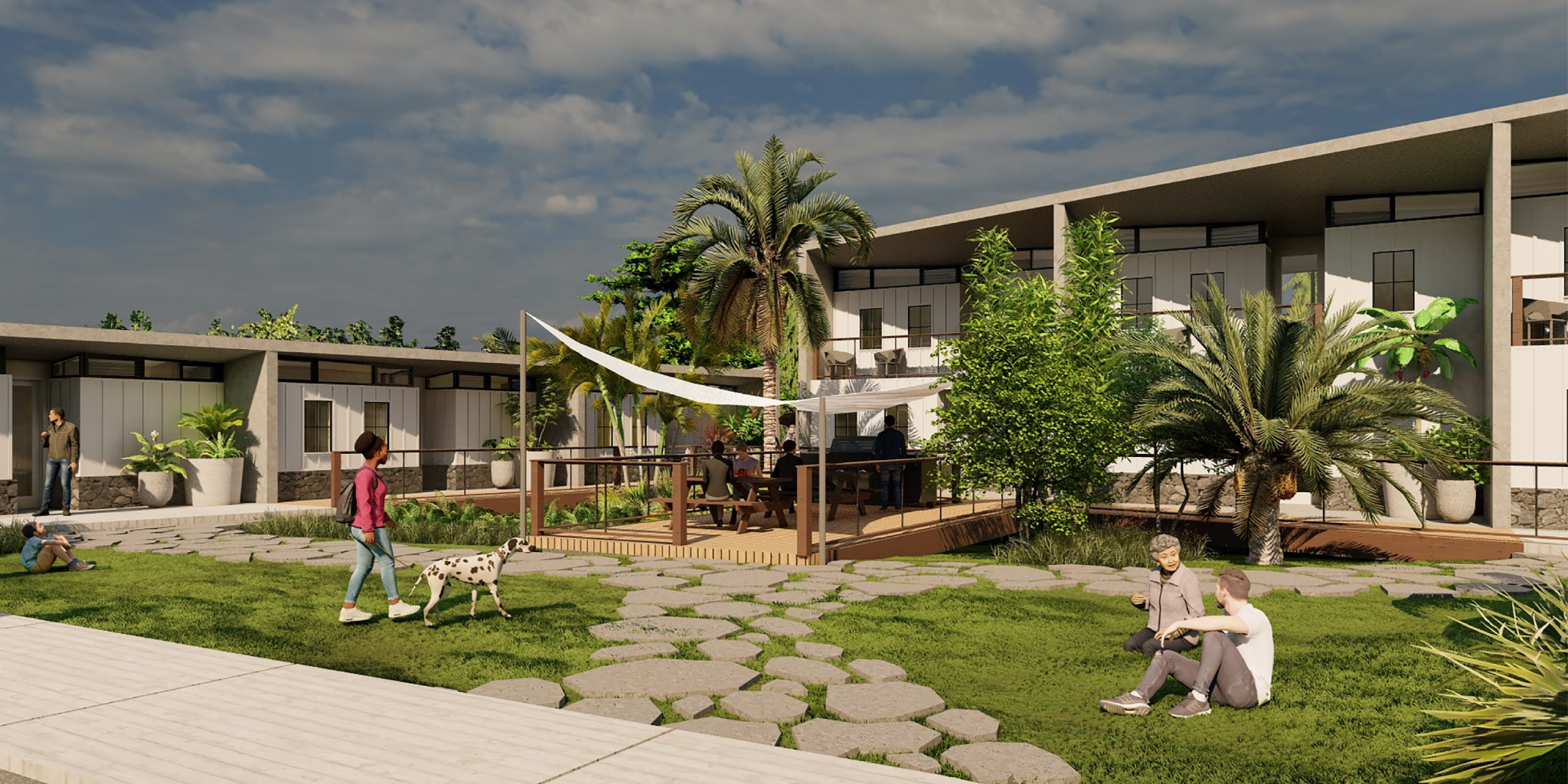
Honorable Mention
Pulelehua – Precast Concrete Housing
Students: Jason Kennell & Lucas Wylie
Faculty Sponsor: Matthew Shea
Institution: University of Colorado Denver
Project Description
The site for this multi-unit affordable housing proposal is within the Waiakea neighborhood of Hilo, Hawaii. Hilo possesses several climatic conditions, most notably receiving an abundance of cloud cover accompanied by roughly one hundred and thirty inches of precipitation a year (two hundred and seventy plus days a year) making it one of the rainiest cities in Hawaii. The currently empty lot we are designing within is situated amidst a cluster of single-family dwellings, just a few blocks from K-12 schools, along with the University of Hawaii Hilo. Thus, making this a desirable location for families with young children to root themselves and call home.
We have designed a modular prototype that uses precast concrete as the structural framework due to its resiliency and longevity. This specific proposal features (3) 1-bedroom units, (3) 2-bedroom units, and (3) 3-bedroom units based on site-specific needs and regulations. Although, the design methods established here can be translated to work with a variety of different sites across the western region. These units are aggregated in a manner that shapes interior and exterior moments to allow for varying levels of privacy based on inhabitants’ comfort levels. Being cognizant of the environment, we look to blur the lines between indoor and outdoor spaces to create more ideal living parameters that are open and connected with the natural elements. We utilize simple performance technologies such as natural ventilation to enhance the health and well-being of our occupants, while also cutting down on energy/utility costs. Our design is fully accessible as all major circulation routes and entry points to units sit at the same elevation. Along with proper widths and turn radii on the interiors of each unit to allow for wheelchairs to properly access the spaces.
Our units function in a linear manner and feature a progression between public and private spaces. The front door of each unit serves as the first threshold as one transition’s from the semi-public front porch into the private dwelling spaces (bathroom, bedroom/s, storage). The use of the butterfly roof accentuates this progression as an overhead sense of compression leads users to the next threshold which splits units programmatically from the private into semi-private living spaces (kitchen, dining, living room). As one moves into these living spaces the overhead condition again comes into play, this time with a reversed sensation of release as one move’s toward the transparent back wall that opens up to a traditional Hawaiian Lanai. This is where we envision inhabitants spending a majority of their time, as it is an extension of their living space that is much more connected with the natural elements.
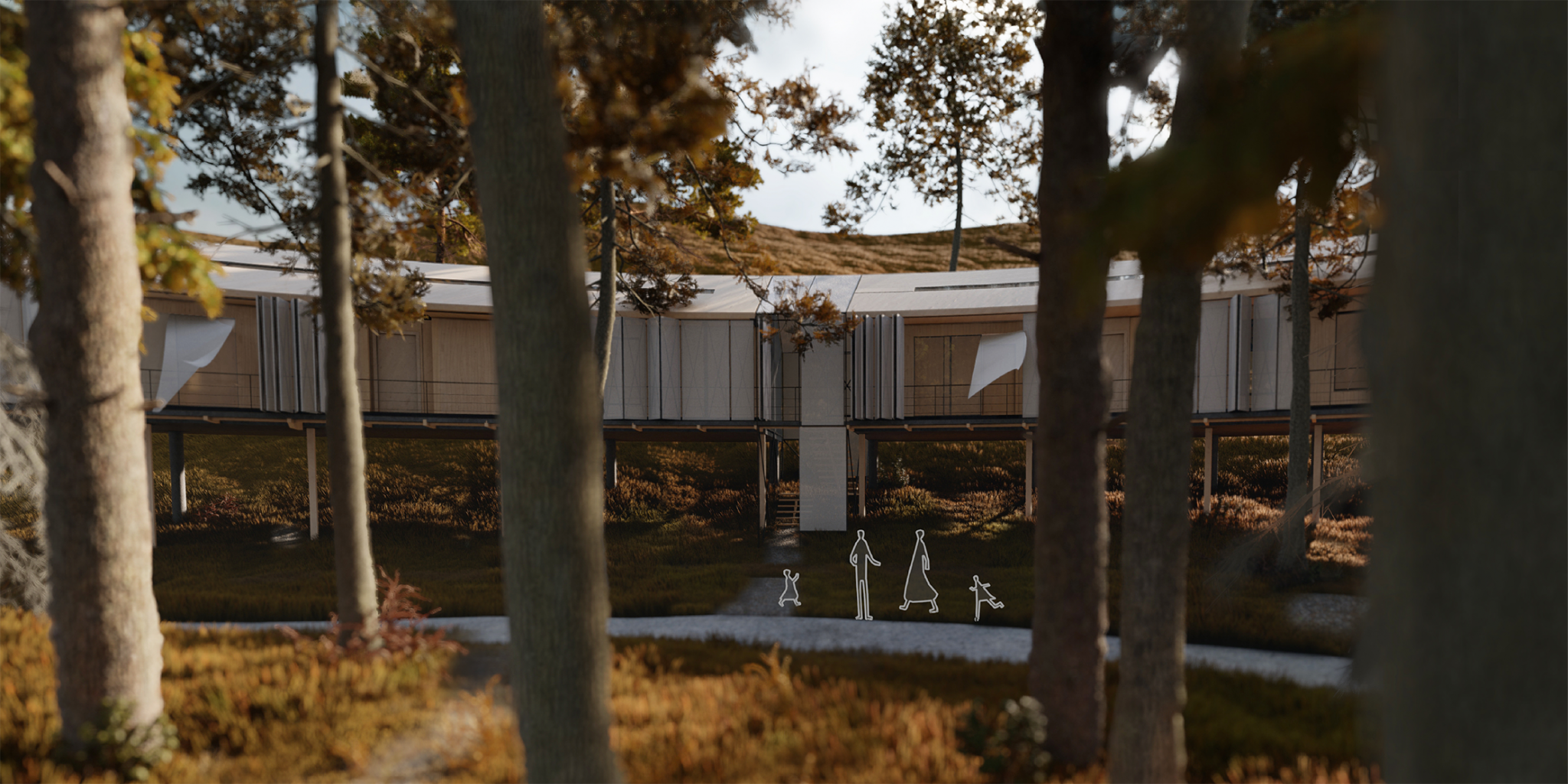
Honorable Mention
Ring’ Habitat
Student: Sanket Gunjal
Faculty Sponsor: Margaret McManus
Institution: Savannah College of Art and Design
Project Description
The early design concept is to adore the sense of place and promote flexibility in design. The heart of the project lies in the shape of the form that plays on the concept of interior-exterior and on the desire to immerse the resident in a unique environment that creates varied sensations as the time changes through the day. The wooden structure on the interior acts as mobile form that can slide into the concrete enclosure based on the residential requirements, like that of a slider onto a track. The form resides into the existing void around the creek, which limits the consumption and processing techniques of the soil, a gesture of integrity to respect the original morphology and the flora and fauna of the region. A generous curved roof encloses in on itself embracing the residential spaces and enabling the resident to establish a connection and familiarize with the neighbors to establish a strong community.
With the freedom of wide views on the exterior it allows the resident to escape the daily pressure and establish their own dialogue with nature physically and spiritually.
This sustainable housing is a strong relation of combined efforts between the community and the habitat for humanity. Designed as a distinctive ring, it allows the residents to merge within the nature. Inspired from the existing topographical and vegetative features of the proposed site, this design is an act of highlighting the strong values of community and adoring the surroundings. In terms of drivers, the raised form helps maintain the level changes as well reduce the ecological footprint in addition to preventing the risks of stormwaters and landslides. The intervention of creek with the form allows to maintain a strong ecology as well as serves as evidence to preserving the natural beauty and the flora and fauna of the region.
The well-studied circular radius provides open and closed views to the units as well as respects each
other’s privacy within the nature. The narrow skylight that runs over the corridors allows for natural and diffused daylighting in the residences whereas the screened panels help control the same into the buffer zones. These transitional panels help open and close spaces with freedom of movement to create perpendicular open passages laterally to the building and help keep the porches clean of snow during winter. The recycled fabric as well as the materiality of the building introduces resiliency into the design.
Meanwhile the design features two distinct materials, concrete which corresponds to the H4H that provides a strong foundation and shell to the community; on contrary, the wood on the interior ring corresponds to that of residents and community that tie together to create a stronger structure; wherein each party being responsible to their respective construction further proposes the sweat equity model for the initiative. The model of providing the concrete element, opens door for development of units based on user needs and prevents construction of all units at the same time.
‘A design that could be relocated or dissolved with zero footprint on the site and surroundings.’
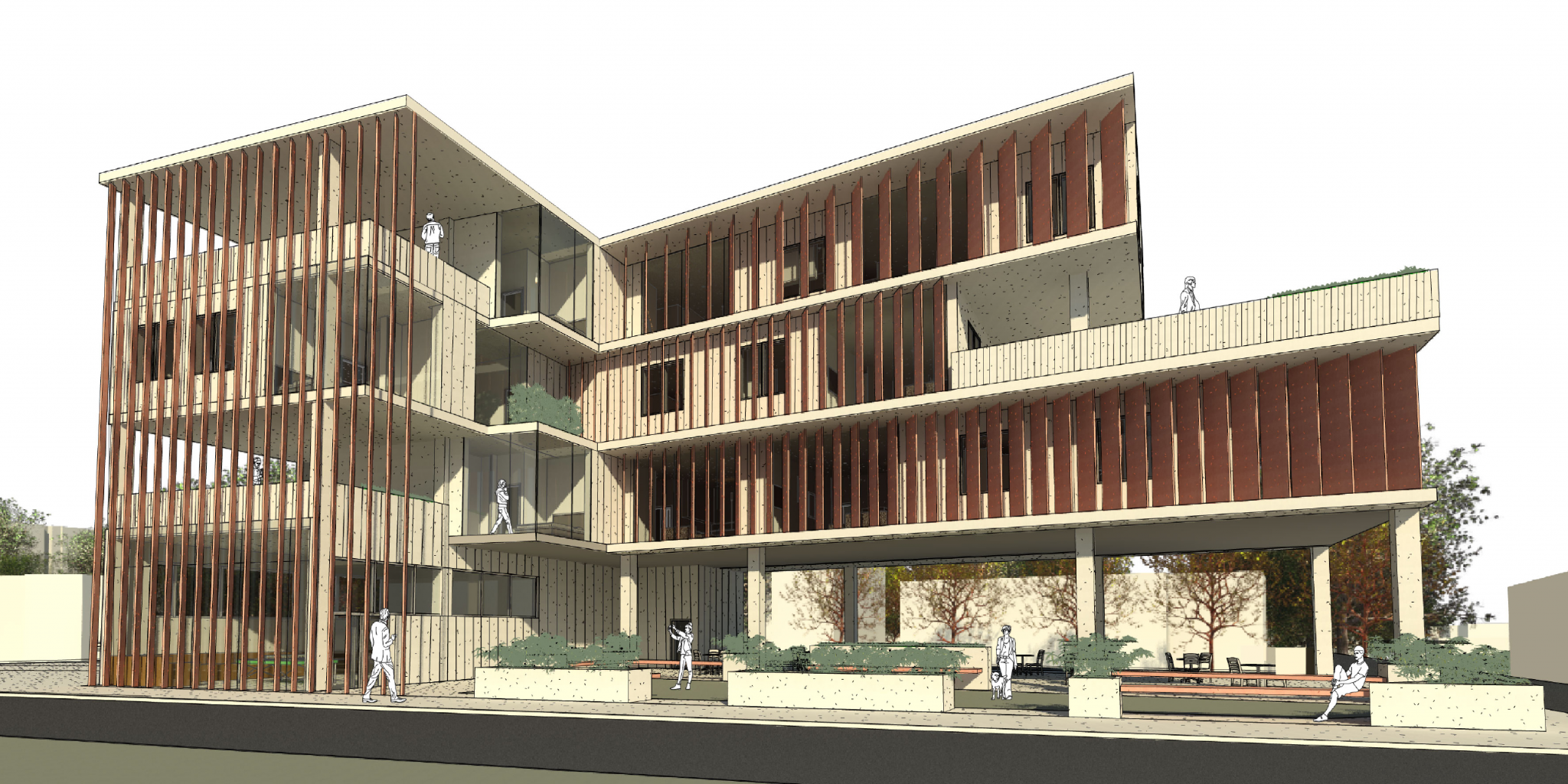
Honorable Mention
Sheltered by Concrete
Student: Veronica Geschwend
Faculty Sponsor: Przemyslaw Swiatek
Institution: University of Illinois, Urbana-Champaign
Project Description
Sheltered by Concrete uses Cast in Place and Glass Fiber Reinforced Concrete as sustainable and logical element within this project. As one of the top growing cities in America, Austin, Texas population is increasing significantly while its cost of living is as well. Because of Texas’s hot and humid summers, creating shade for the building and the site is the concept behind the design. Using the structure and brise soleil provides a shaded, sustainable environment for the residents and the community. The exposed floor slabs to the exterior of the building is used as a sustainable element to control the temperature of the interior of the building passive heating and cooling techniques. The use of Brise Soleil is made from glass fiber reinforced concrete to have a sleek, slim façade that cools the residential units. The overlapping planes of the levels allow for as much shade as possible to the lower levels and creates shareable outdoor spaces for the residents. As the net migration of Austin keeps growing, there is a need of communities that make up the city. By creating these spaces on the site and in the building, the residents are able to form relations with one another and those in the Austin area. Forming these types of spaces allow communities to prosper, that is exactly what is intended for Sheltered by Concrete.
The site of Sheltered by Concrete includes a public lawn and shaded plaza for the surrounding community. The plaza will provide a variety of amenities to the public such as; food truck, local business promotions, seed exchange, farmers market, etc. On the ground level of the building, the residents are provided with an amenity room for lounging and a mail room. The vertical circulation is at the core of all of the floors for easy access to residents. The second through fourth levels have a total of 10 units, two of which are two bedroom/ one bath, and the rest are 1 bedroom/ 1 bath. The horizontal circulation is on the exterior sides of the building including a shaded outdoor amenity area on each floor specifically residents only.
Participating Schools
The competition had over 500 participants from the following schools:
Cuesta College, James Madison University, Kean University, Kennesaw State University, Louisiana State University, Massachusetts Institute of Technology, Mississippi State University, New Jersey Institute of Technology, Polytechnic University of the Philippines, Pontifical Catholic University of Puerto Rico, Prairie View A&M University, Pratt Institute School of Architecture, Ryerson University, Savannah College of Art and Design, Southern Illinois University, Syracuse University, Texas Tech University, University of Colorado Denver, University of Idaho, University of Illinois, Urbana-Champaign, University of Kentucky, University of Manitoba, University of New Mexico, University of Texas at Austin, University of Toronto
Competition Organizers & Sponsors
Questions
Edwin Hernández
Programs Coordinator
ehernandez@acsa-arch.org
202.785.2324
Eric W. Ellis
Senior Director of Operations and Programs
eellis@acsa-arch.org
202-785-2324

 Study Architecture
Study Architecture  ProPEL
ProPEL 